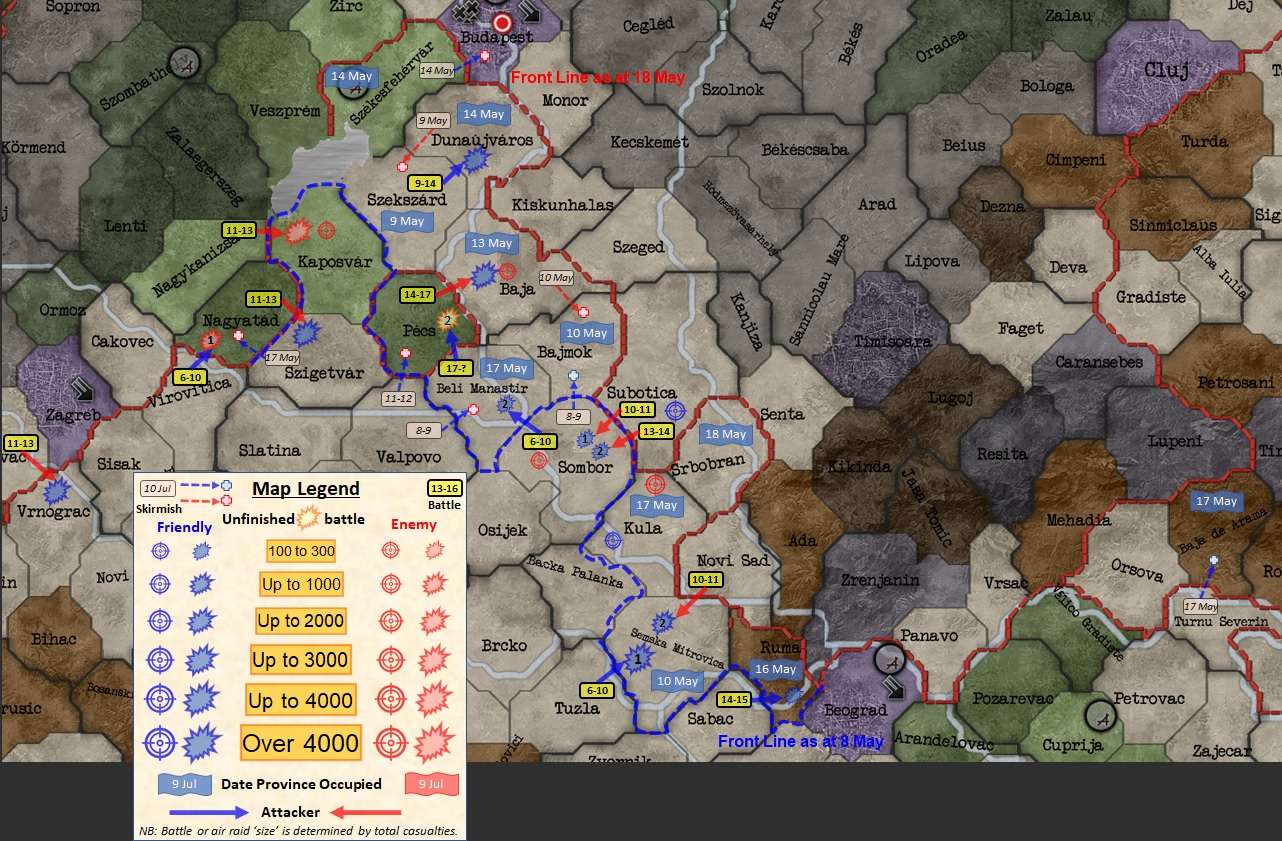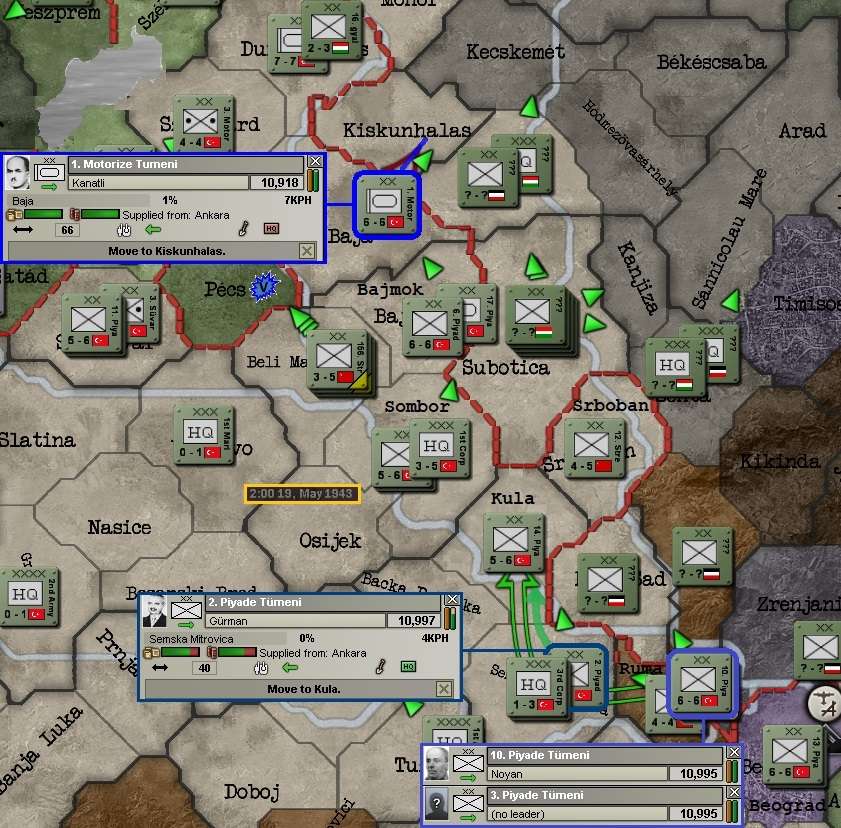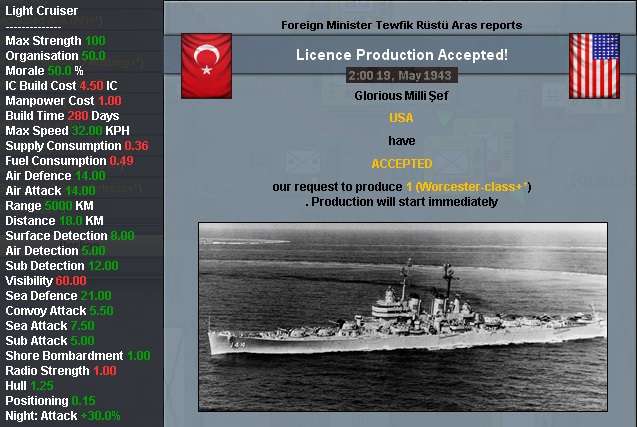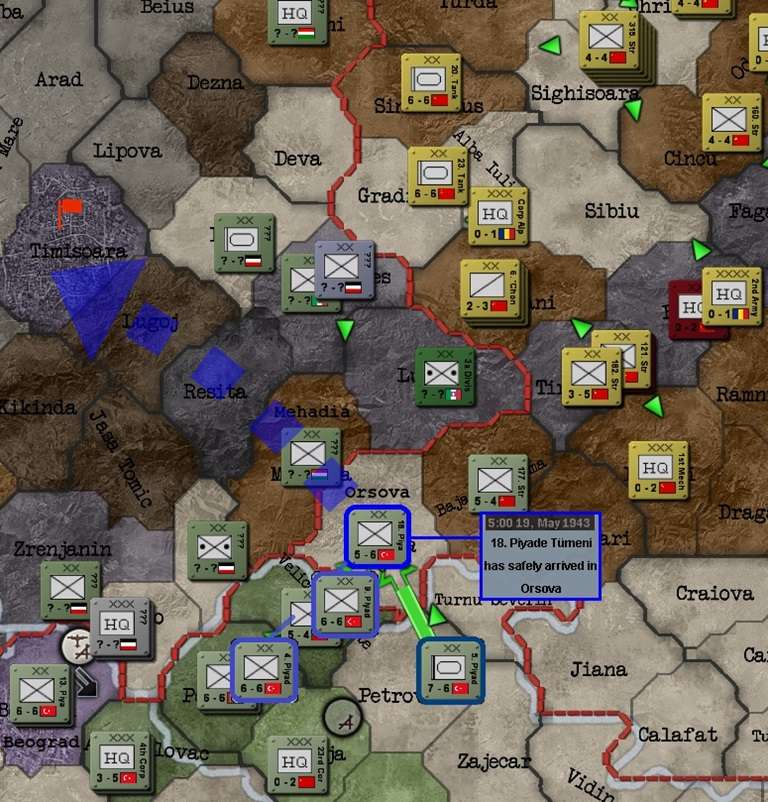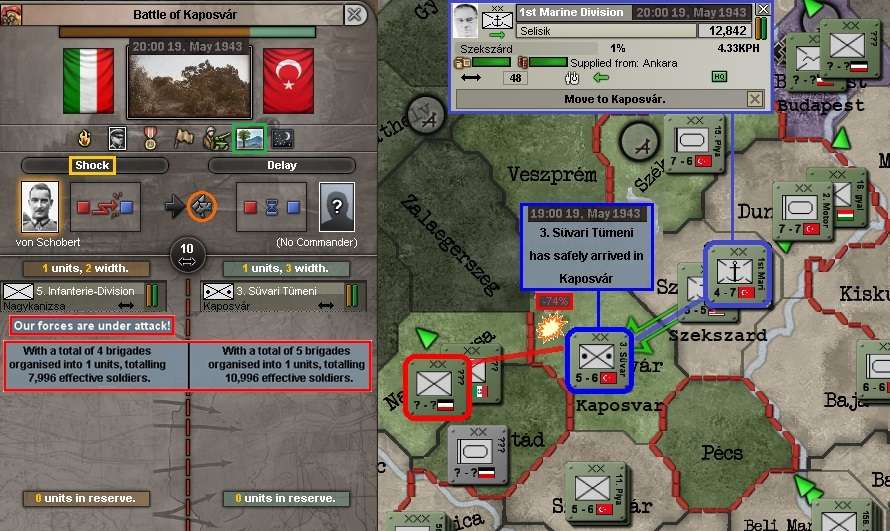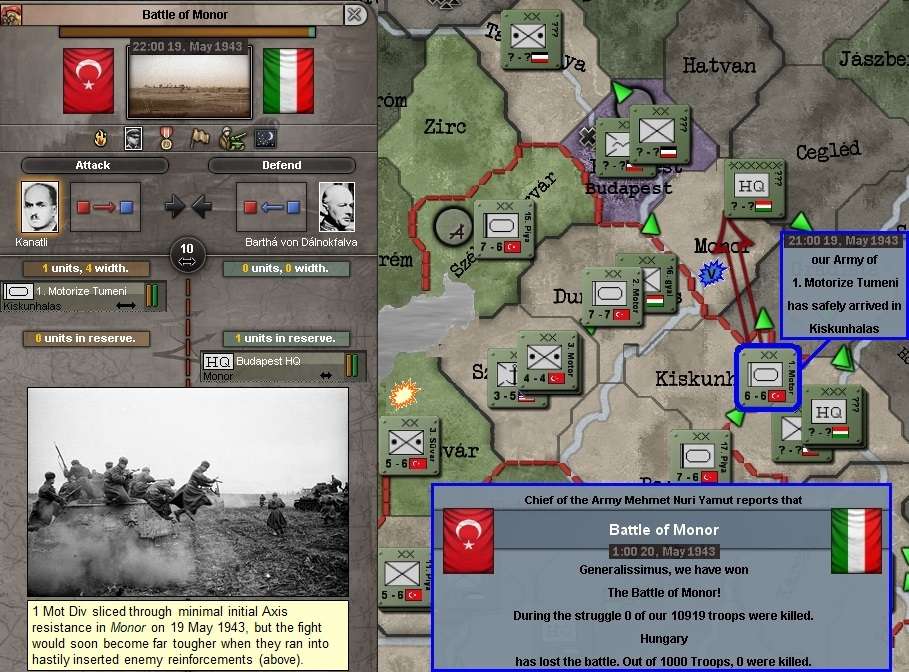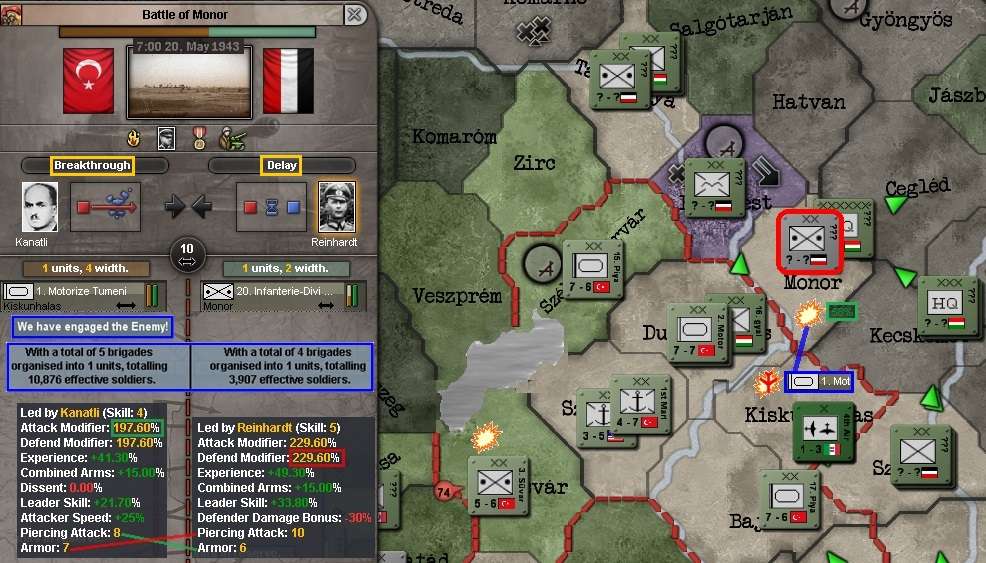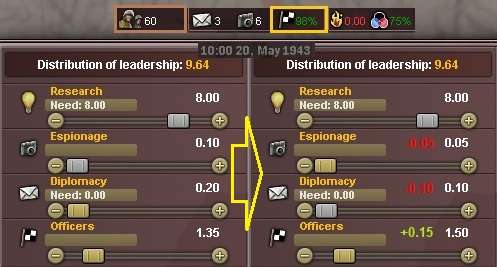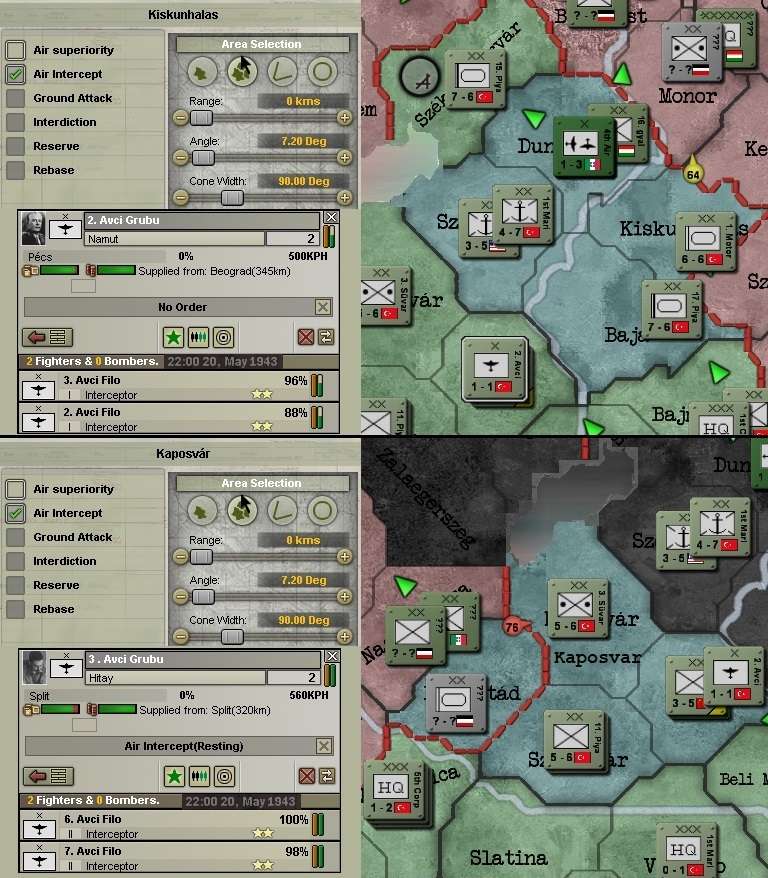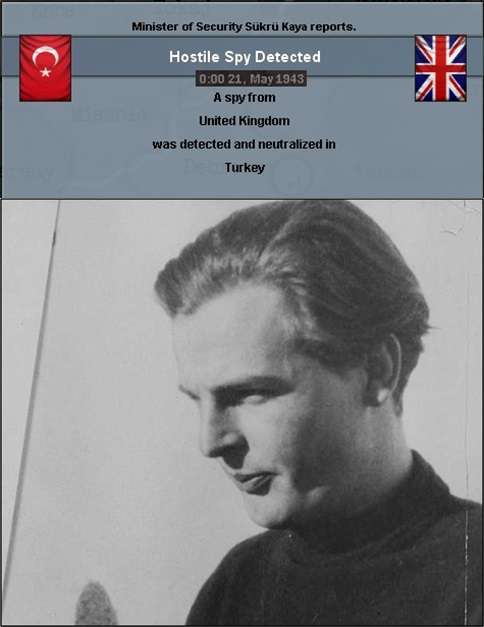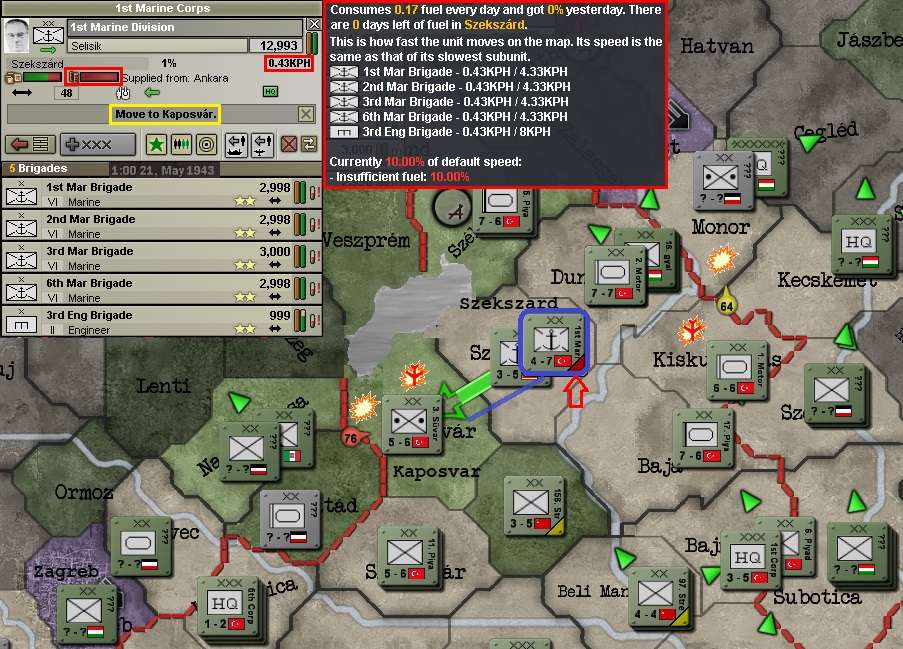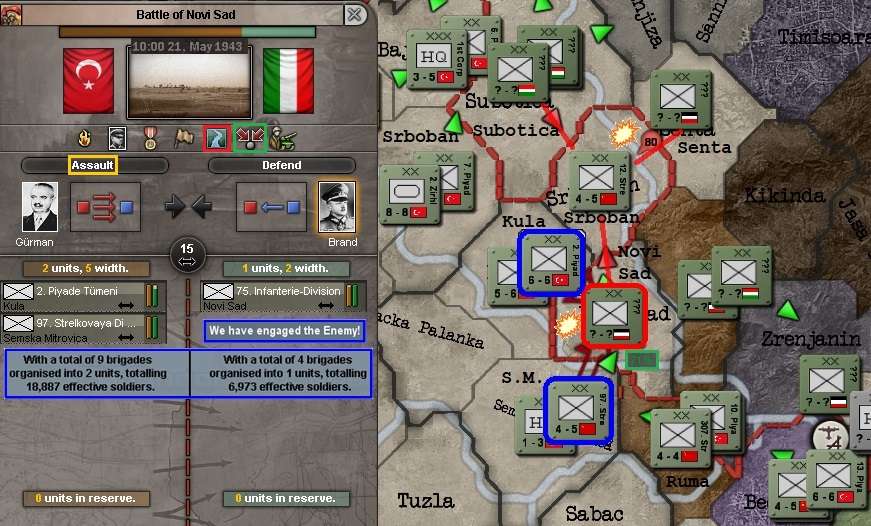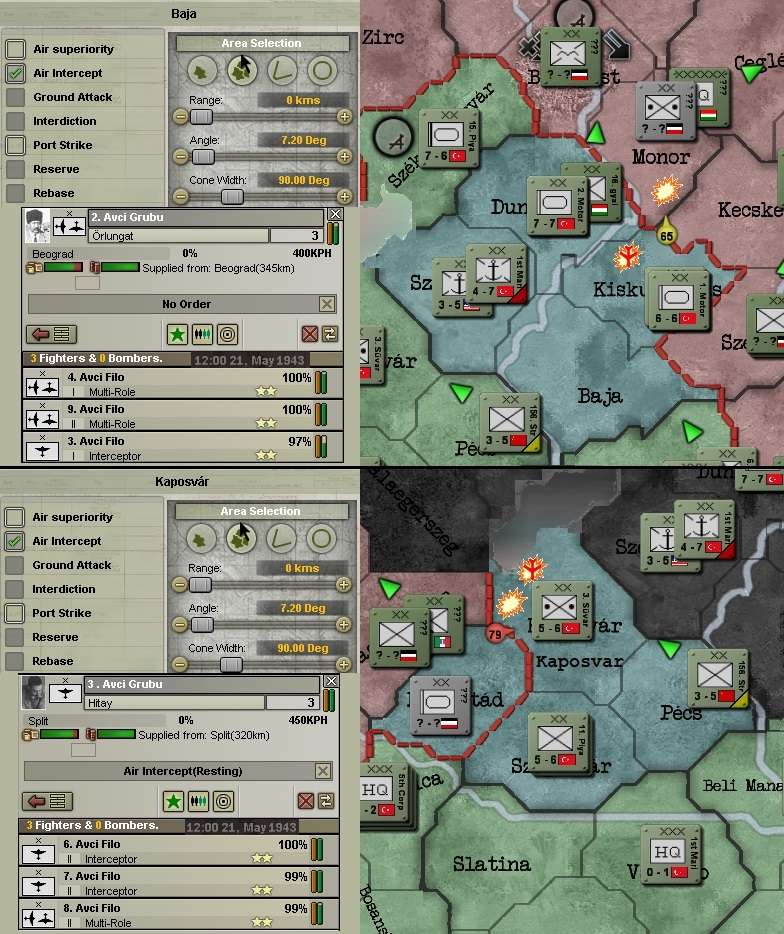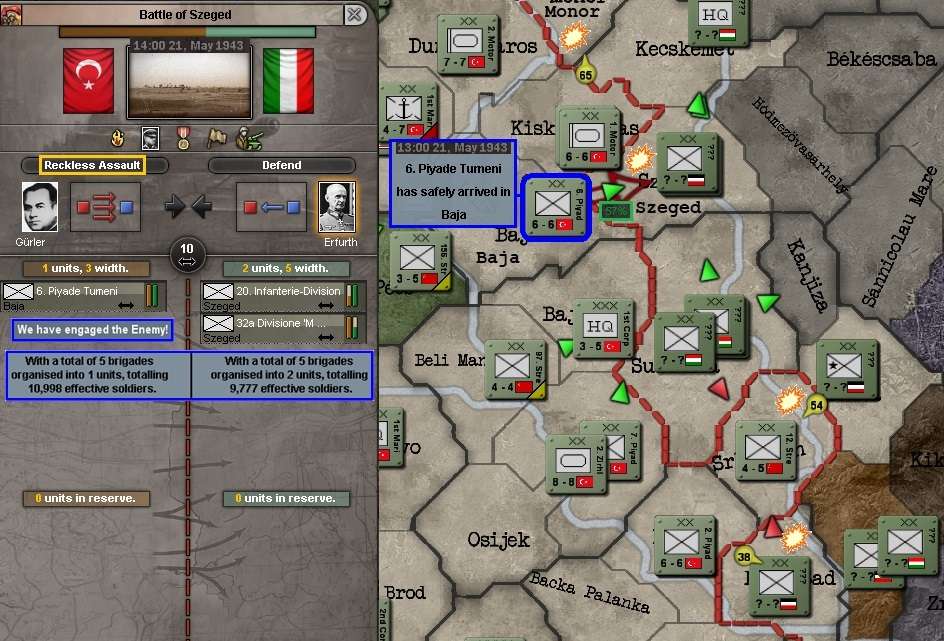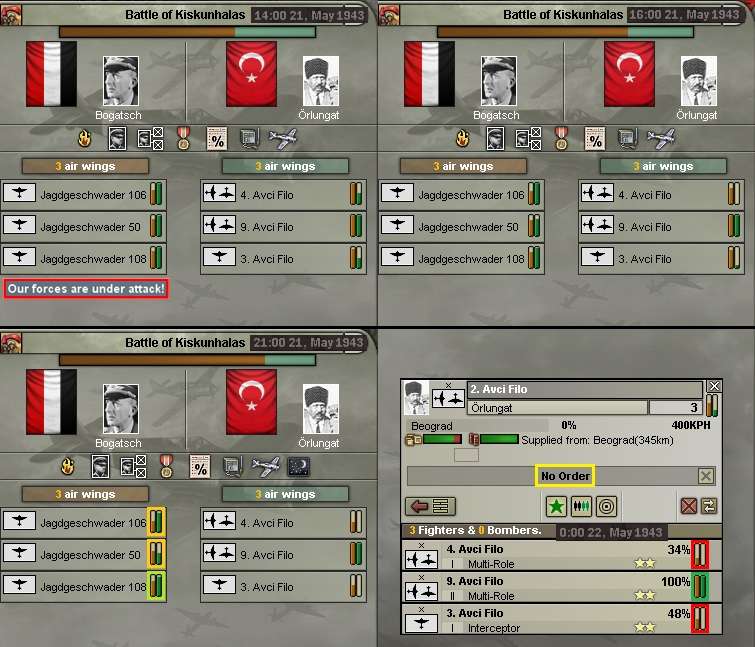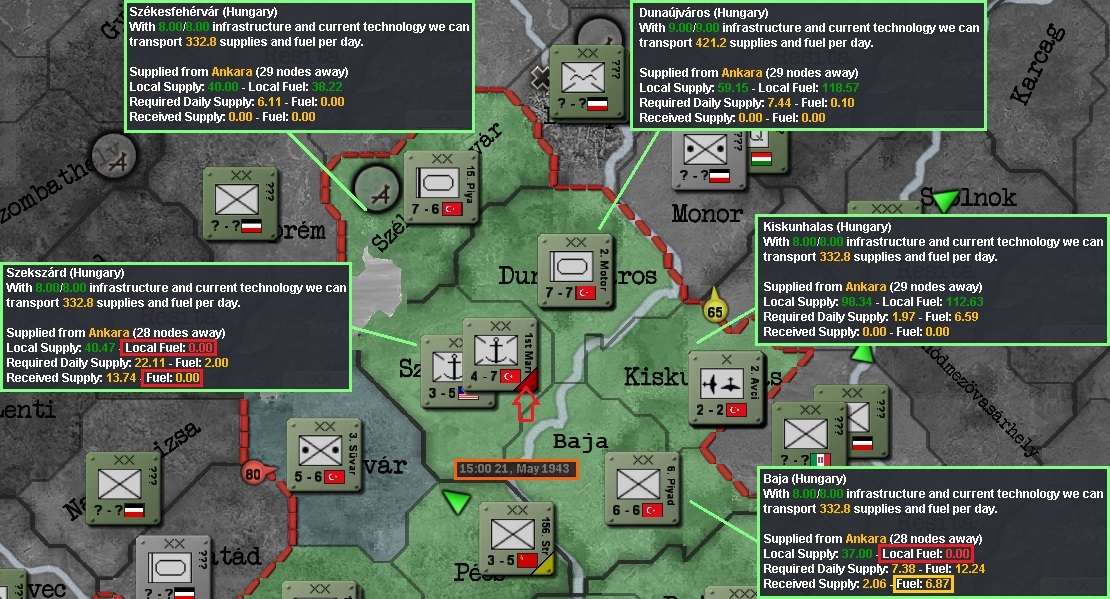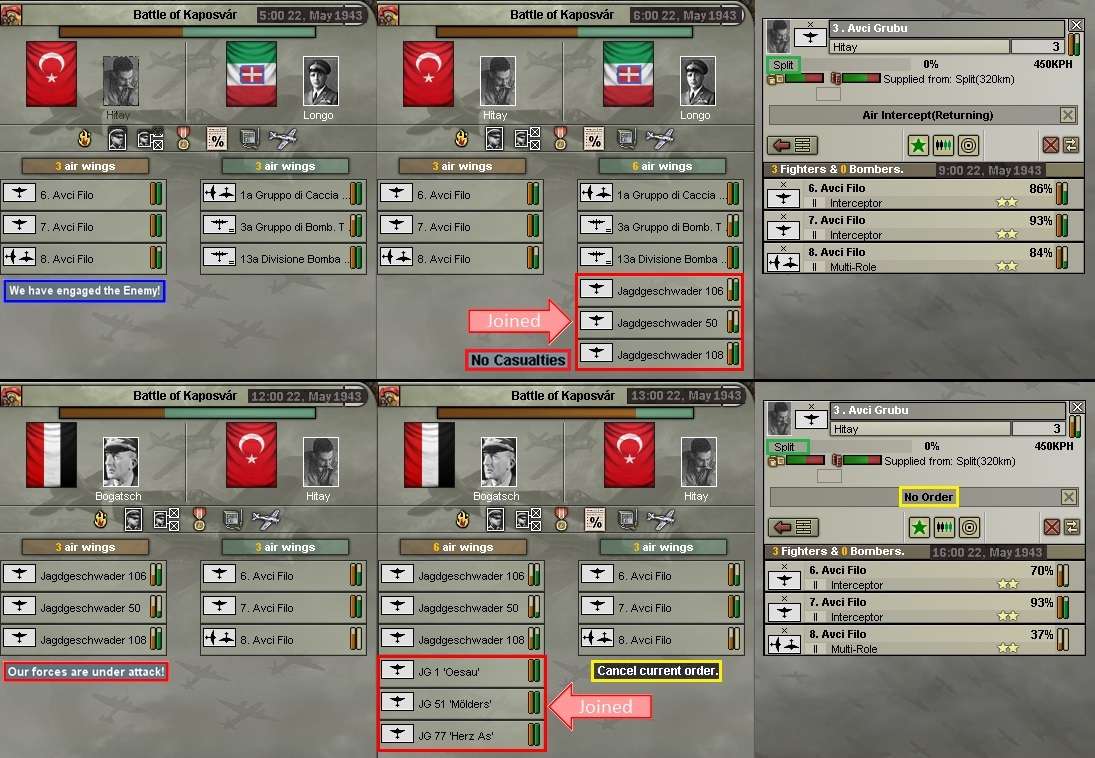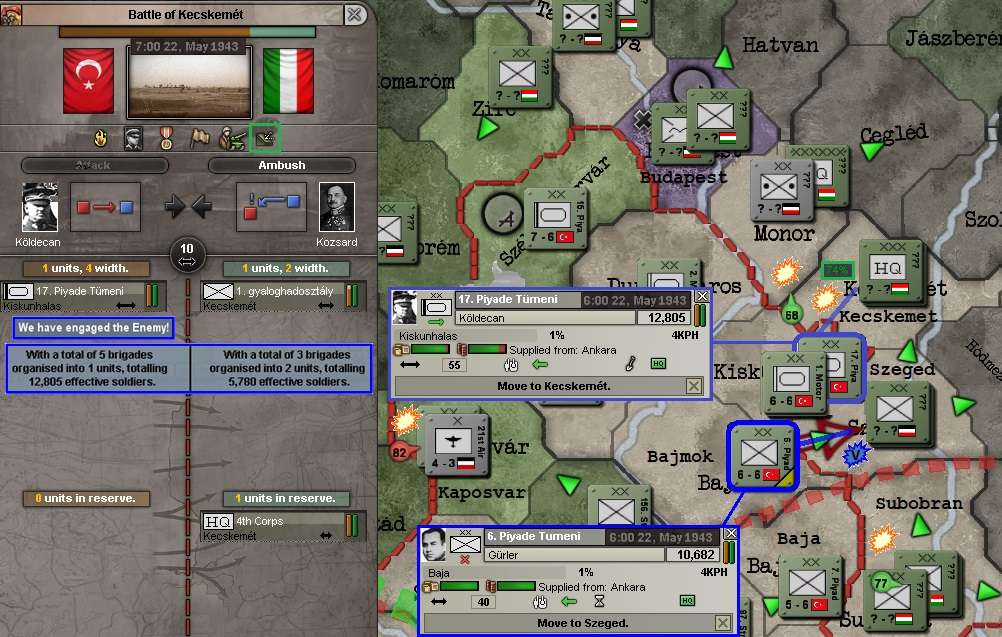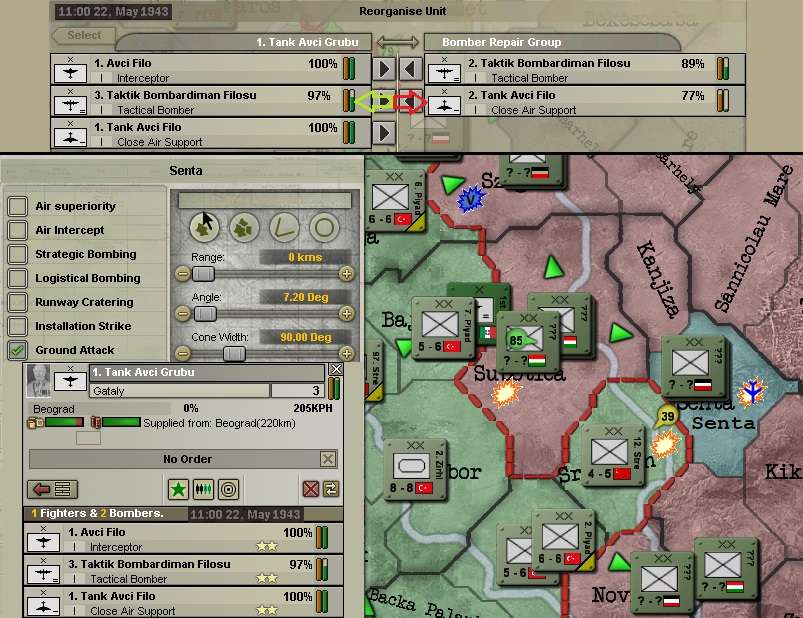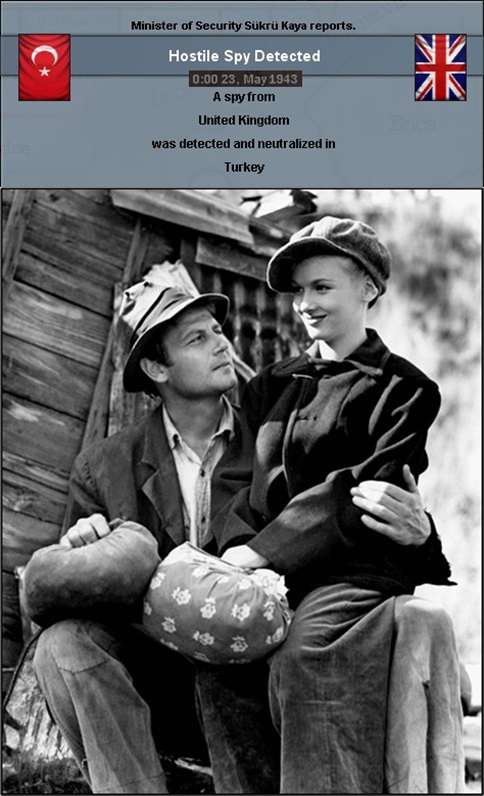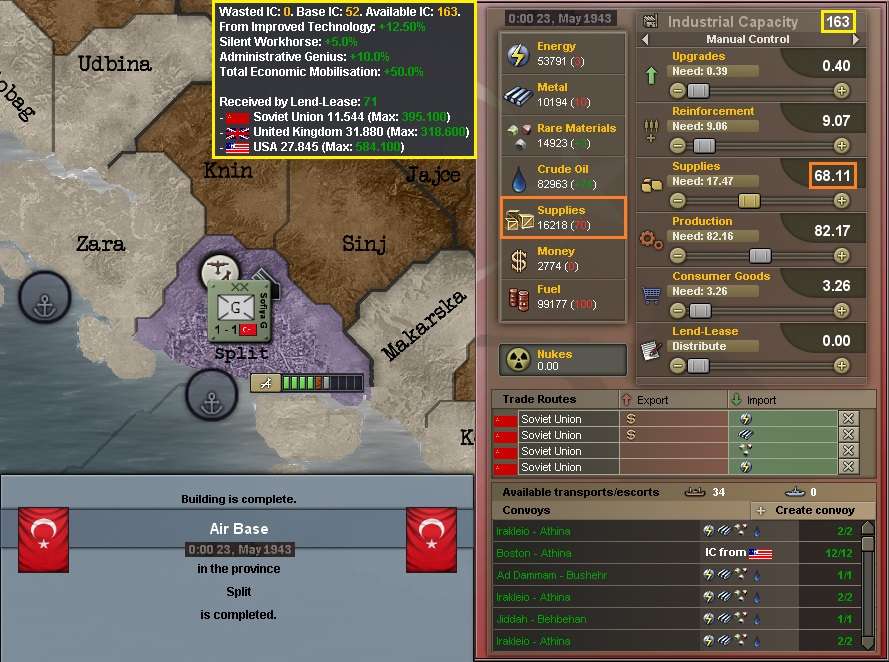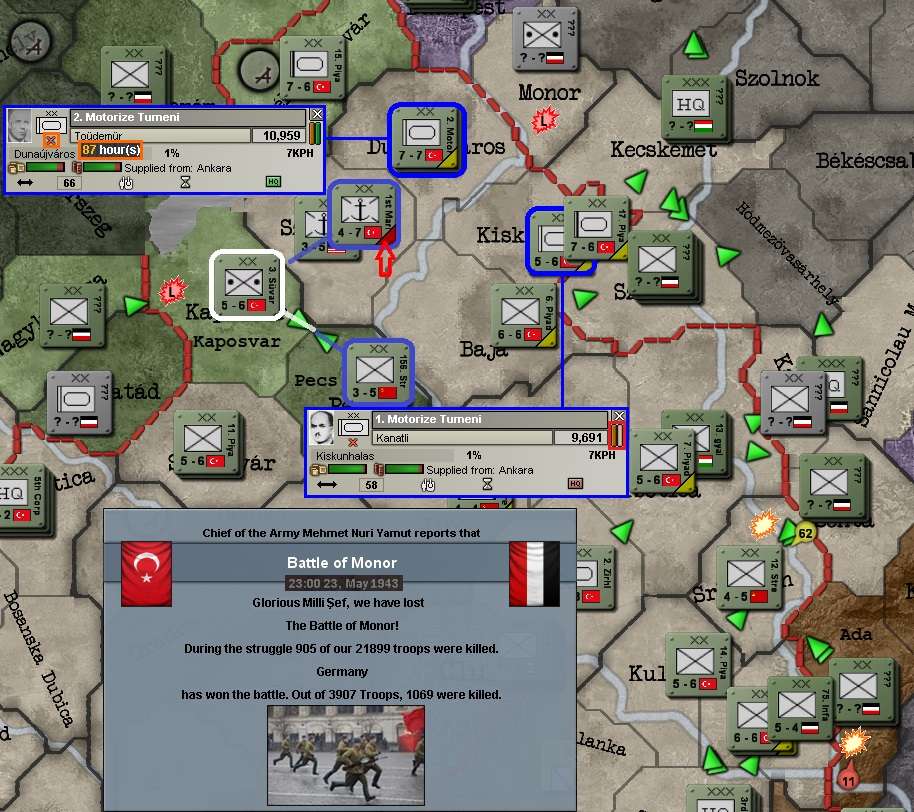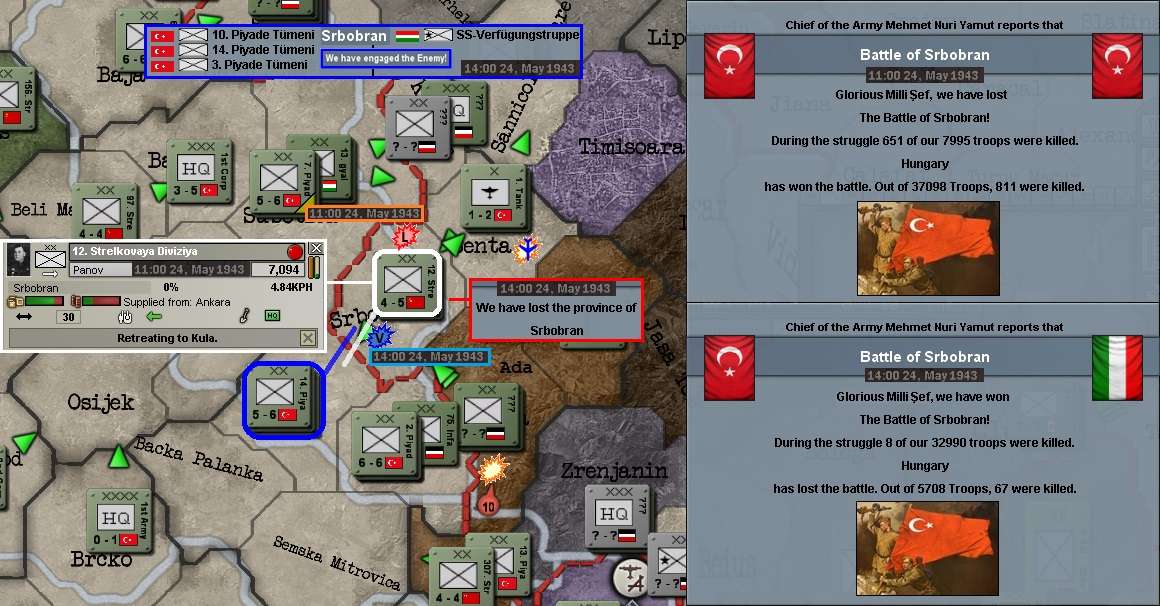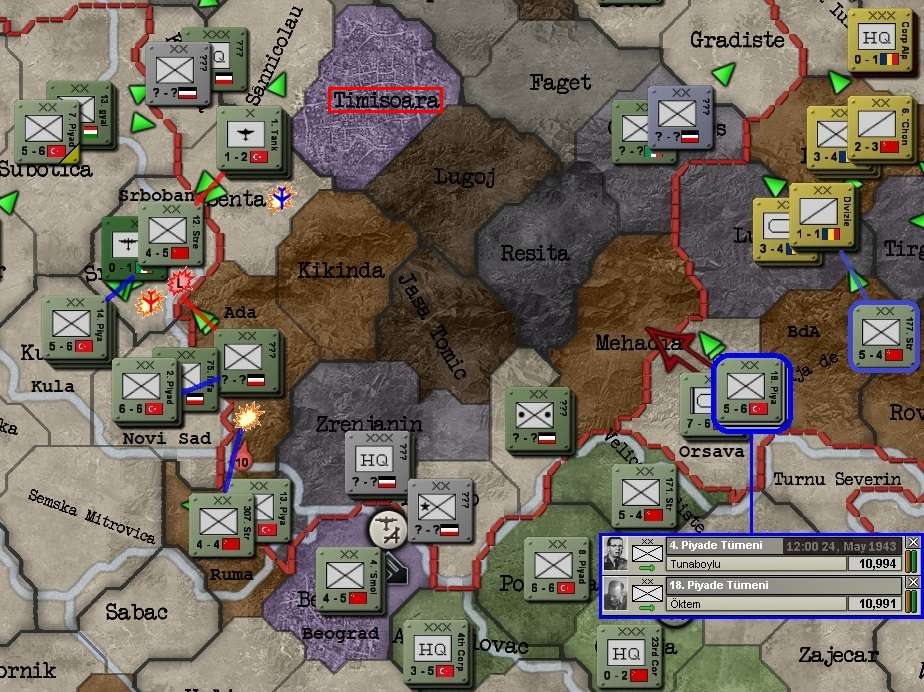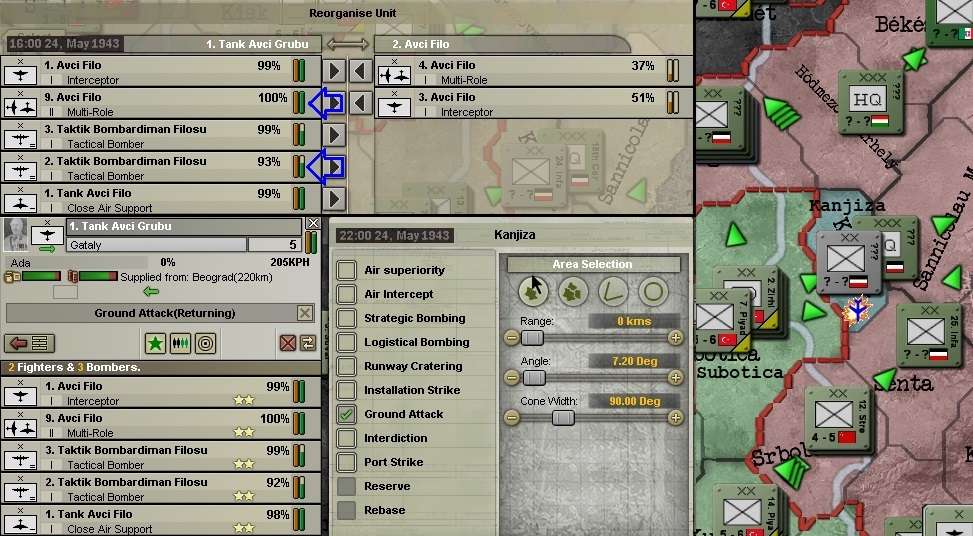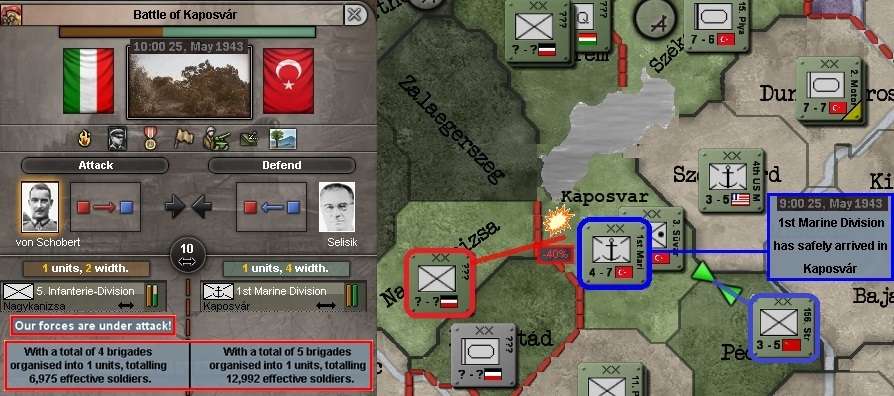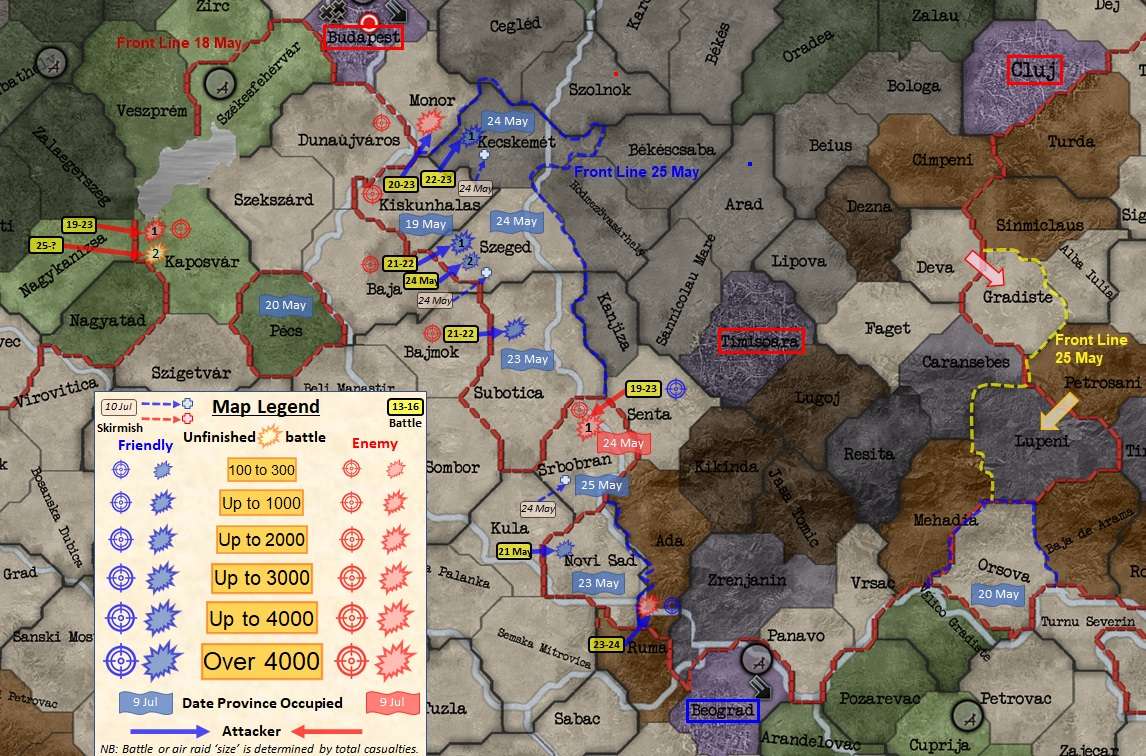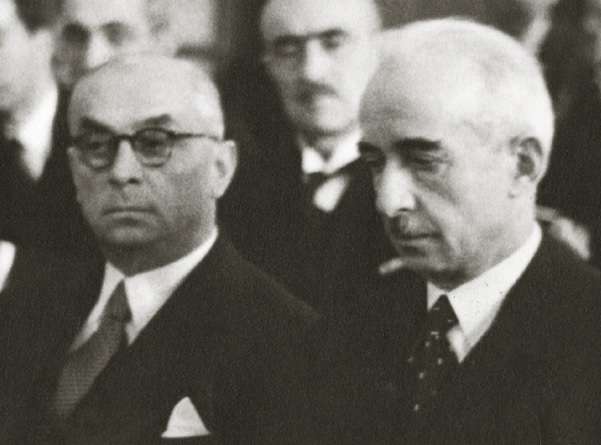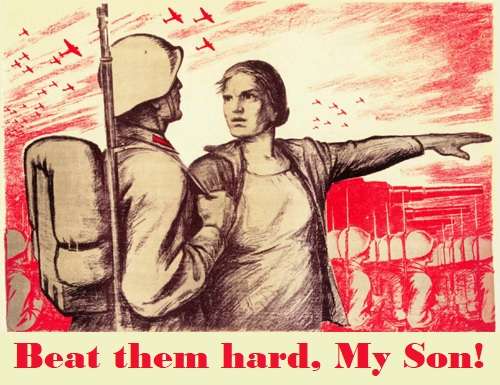Chapter 200: Into the Breach (9 to 18 May 1943)
Chapter 200: Into the Breach (9 to 18 May 1943)
AuthAAR’s Note: Here we have a combat-focused episode, as the Turks and their Comintern partners attempt to capitalise on their recent hard-fought breakthrough in the Spring Offensive. Note, the whole month was played through, so these chapters will progressively bring us back up to the in-game ‘present’ at the end of May 1943.
Recap: The Front Line - 8 May 43
As a reminder of where things are up to, the map below shows action in the breakthrough area during the first eight days of May 1943, as Inönü decided to chance his arm by trying to exploit both north towards Budapest and east to Timisoara – the latter meeting particularly heavy resistance and frequent Axis counter-attacks. Battles continued at Bajmok and Semska Mitrovica.
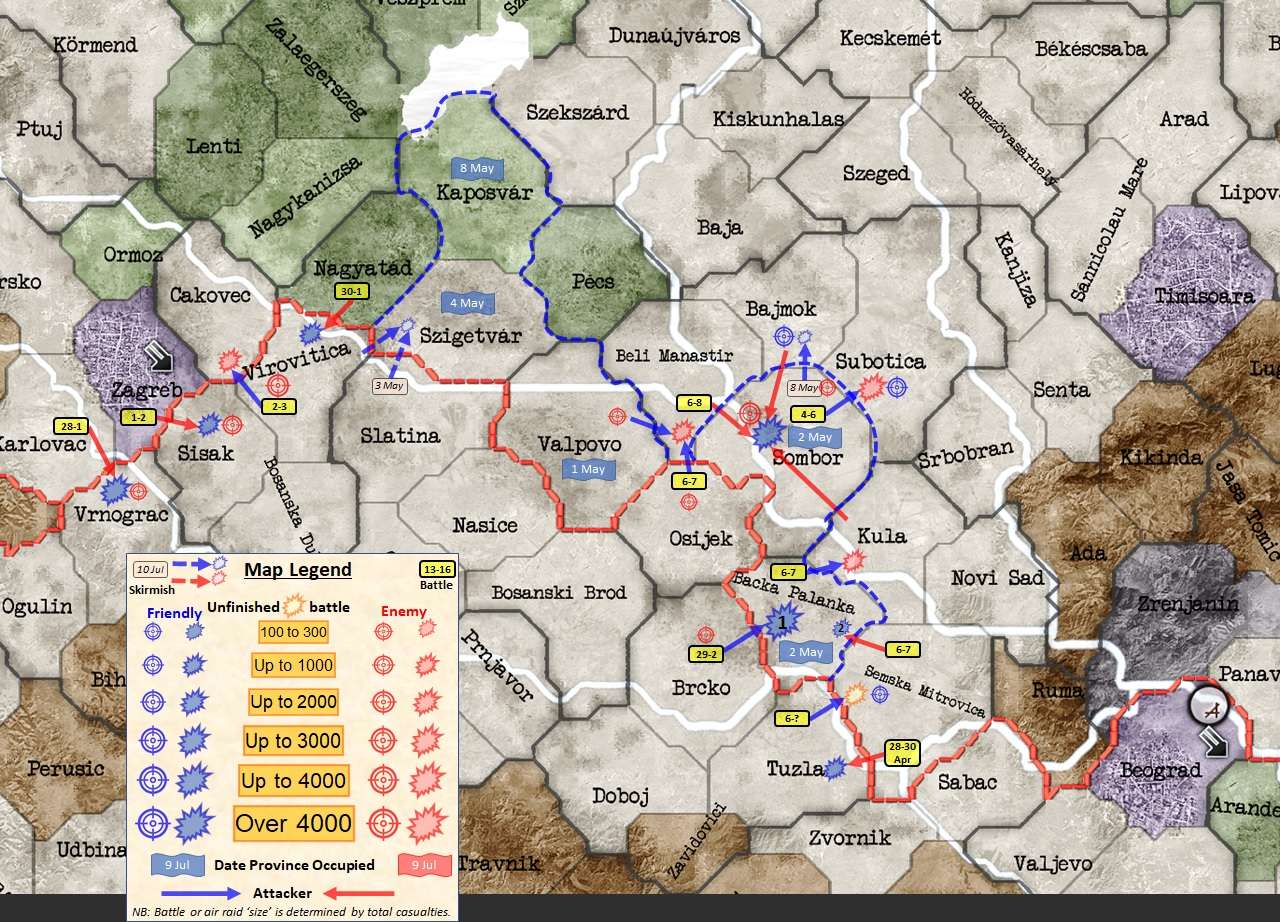
The blue dotted line shows the front as at 2300 hr on 8 May 1943.
---xxx---
9 May 43
A skirmish in Bajmok was won at 1am as two advancing Turkish divisions brushed away a light defence. If it could be occupied, it started to threaten encirclement of Pécs and Beli Manastir to its west, while also offering another avenue to hook east towards Timisoara, keeping the Axis from firming up a new defensive line.
At 2am, Soviet troops from 12 SD in Backa Palanka joined four other Comintern divisions attacking two Axis divisions in Semska Mitrovica, though were yet to reinforce. Importantly, unlike the other four, if they could reinforce they were not approaching over the Sava River.
Then in the north, later that morning the fast and powerful 2 Mot Div joined 3 Mot Div (-) (which had arrived there the afternoon before) to reinforce the breakthrough into Kaposvár, where they too took the calculated risk of pushing on to Szekszárd before the follow-on units had secured Kaposvár and the supply line running through it. But if they waited, the current opportunity may disappear.
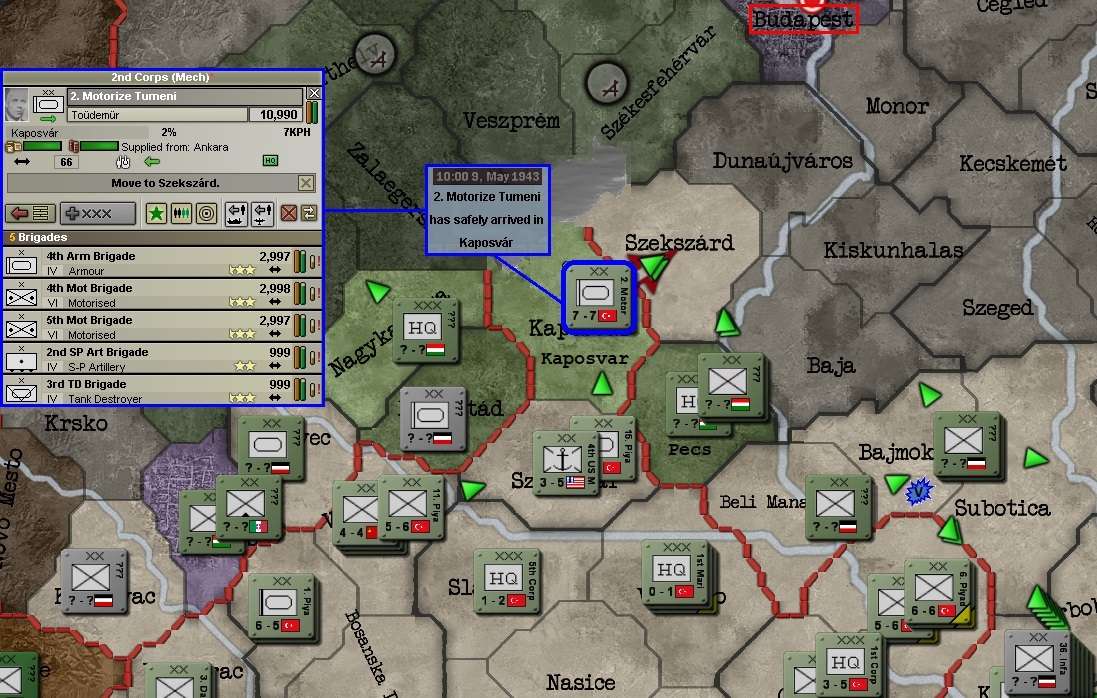
15 Inf Div were not far behind, arriving in Kaposvár at 1pm: but instead of staying to secure it, the still partly disorganised formation also pushed on to Szekszárd, as Axis divisions in Pécs must have spotted the developing trap and now started marching north to escape to Szekszárd themselves. An hour later, 4 US Mar Div was in turn ordered to march north up to Kaposvár from the original bridgehead at Szigetvár, with two divisions on their way from the south of the Drava River to relieve them in turn.
That night, the advance guard of 3 Mot Div (which had no permanent commander) arrived in Szekszárd at 7pm, encountering the unprepared 4th Hungarian Division, which retreated on contact. Having been ordered all the way through, they kept going to Dunaújváros, where they struck the 16th Hungarian Division at 8pm. Their attempted shock attack was however negated by an ambush, though the Hungarians had not had time to dig in [43% progress].
Air Damage Report. Turkish air raids in support of the attack on Semska Mitrovica, which had begun on 6 May, continued throughout the day. Turkish raids on Kula, begun on 8 May, killed 146 Axis troops by the time they finished on the morning of 9 May. There would be no renewal of Axis air attacks until 16 May.
10 May 43
1 Mot Div reported they had arrived at Bajmok at 5am, with 17 Inf Div following up from Sombor. At 6am, the lead elements of the Axis troops trying to escape from Beli Manastir pulled back after a very brief skirmish.
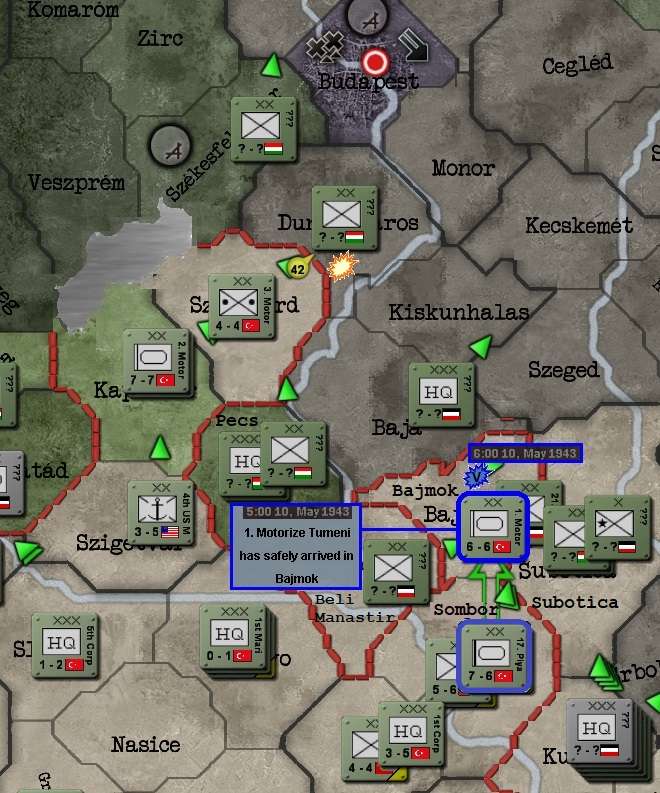
At 10am, 3 Cav Div (a light motorised formation these days) hit Beli Manastir from Valpovo, intending to keep them pinned in place. But they were attacking over a river and immediately started taking disproportionate casualties, so broke off the attack before more men were killed.
Just an hour later, word came over the radio command net of a major victory in Semska Mitrovica: 2 Inf Div had occupied it just an hour later. But as they waited for the rest of their comrades to join them, they were counter-attacked by German and Hungarian troops at 3pm.
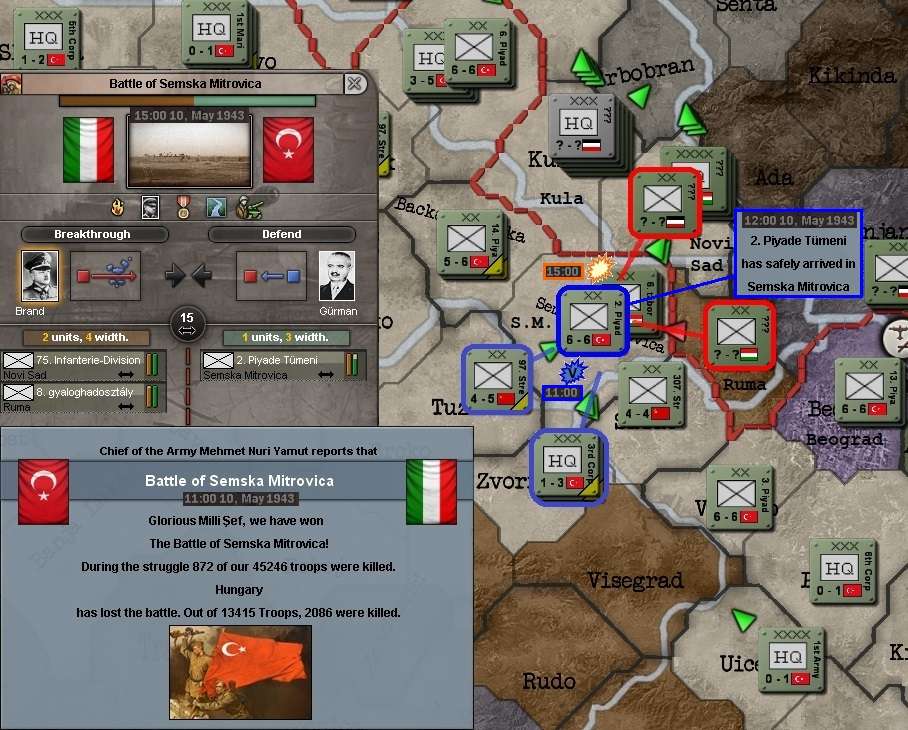
As that attack began, to the north 2 Mot Div arrived in Szekszárd and advanced to reinforce the attack on Dunaújváros [now up to 81%].
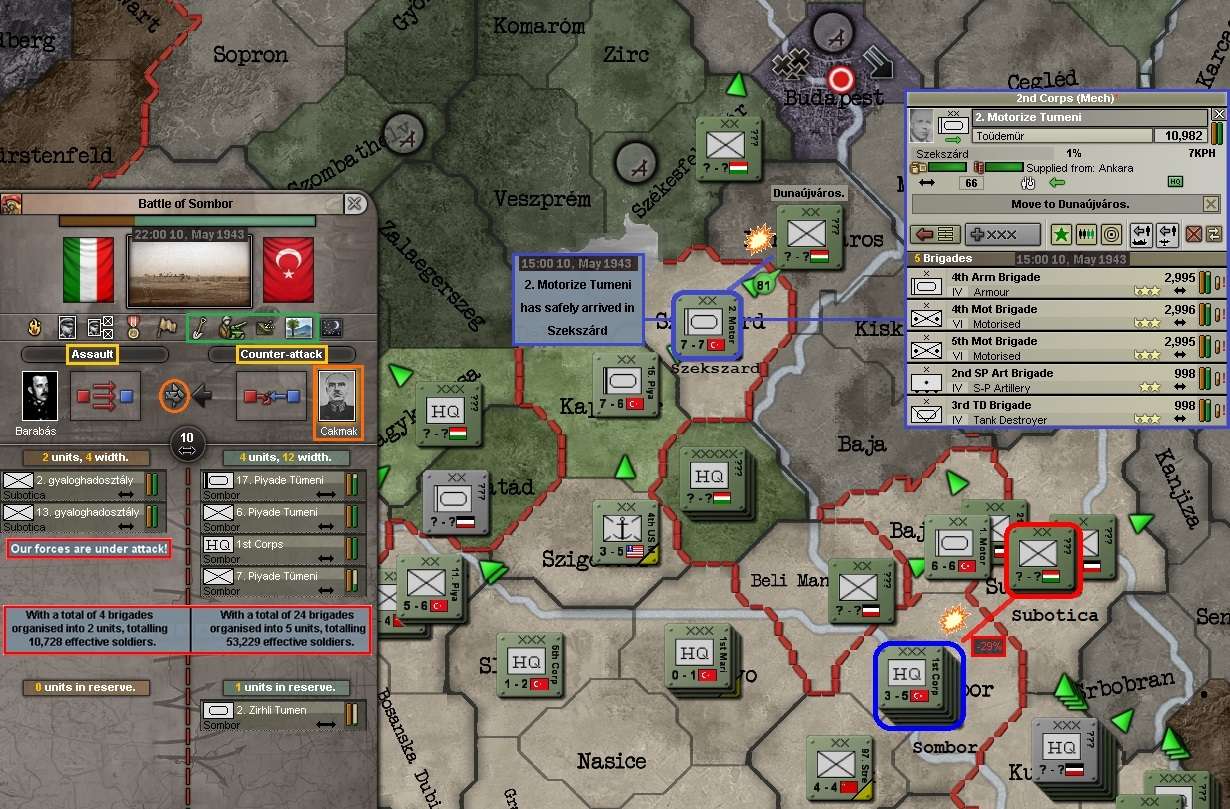
Then at 8pm, the Axis counter offensive in the south intensified, when two Hungarian divisions struck Sombor from Subotica. The superior generalship of LTGEN Cakmak was more than equal to the task however, ordering a counter-attack on the enemy assault, adding to the defenders’ advantages in terrain, entrenchment and armour.
That night, 1 TAG (the IL2s and with Hawk III escorts) were switched to Subotica to try to disrupt the Hungarians attacking Sombor.
Air Damage Report. Ten supporting air raids by the Turks (Yak-4s from 1 TAK) on Semska Mitrovica from the evening of 6 May until the morning of 10 May killed 608 Axis troops.
11 May 43
By 3am, the Hungarians attacking Sombor had had enough: they stopped their assault, having lost 221 men to the Comintern defenders’ 40 casualties. They would continue to suffer more casualties from both Turkish bomber groups for the rest of that day and the next three afterwards.
6 Inf Div were the next to reinforce the breakthrough in Bajmok at 9am, but they were subject to post-attack reorganisation and were therefore unable to push on, where the seizure of Baja would cut off at least three Axis divisions in a possible Pécs-Beli Manastir pocket: the Axis units in Pécs had halted in place.
The enemy attack on Semska Mitrovica failed at 3pm (Comintern 241 v 317 Axis casualties), by which time 2 Inf Div had been joined by two more divisions. At the same time, 15 Inf Div had arrived in Szekszárd, where they were sent north to exploit to Székesfehérvár, in the hope of flanking the continuing battle in Dunaújváros – slipping into Budapest by the ‘back door’.
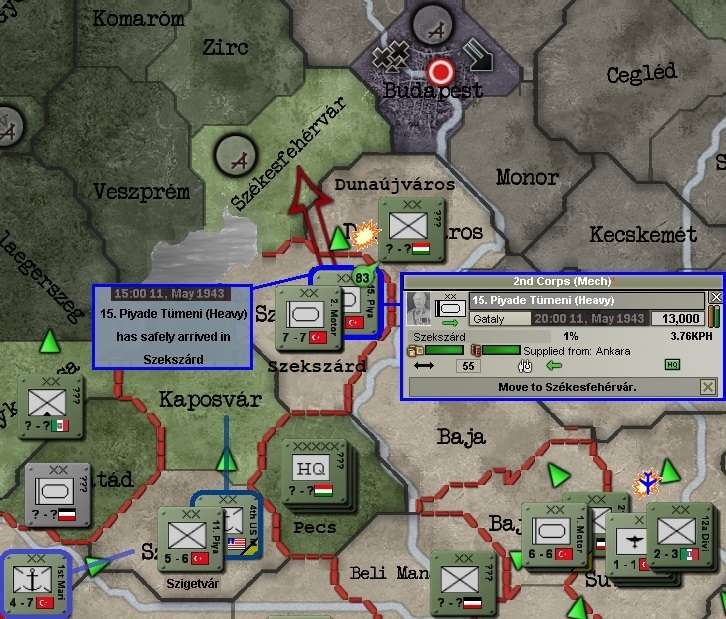
Not that things had been quiet to that point, but between 10pm and midnight, all hell broke loose across the northern part of the front.
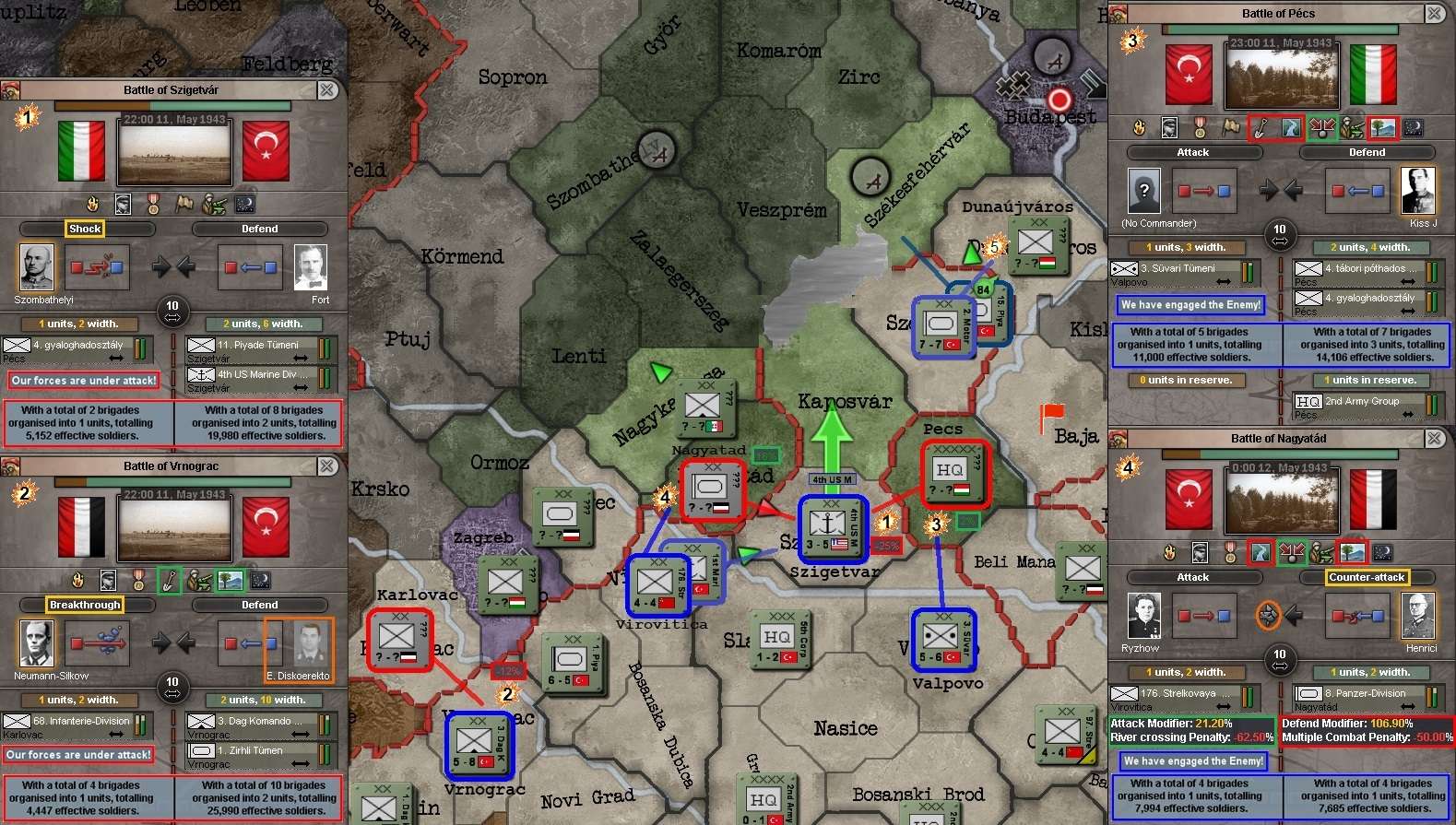
To the south, the Turkish Air Force continued to strike Subotica throughout the day, now with the purpose of softening it up for the next attack.
OTL Event: Operation Mincemeat. U.S. Secretary of the Navy Frank Knox inadvertently gave a clue that Allied forces intended to use Sicily for an invasion of Europe, potentially undermining the British disinformation campaign of Operation Mincemeat to convince German intelligence that the attack would be made from Greece and Sardinia. Ironically, Knox's comment that "Possession of Sicily by the Allies would obviously be a tremendous asset" was interpreted as an obviously clumsy attempt at deception, which Nazi Propaganda Minister Joseph Goebbels would describe as "baseless rumors and attempts at a smoke screen". [Comment: mistakenly tell the truth often enough and it will be interpreted as a lie!]
12 May 43
Kanatli’s 1 Mot Div rolled into Bajmok at 2am and – unhindered by any reorganisation delays – were able to keep going straight towards Baja. Not only might the ‘Pécs Pocket’ be closed off, but it would open up an alternate supply route to the dangerously exposed forces advancing on Budapest.
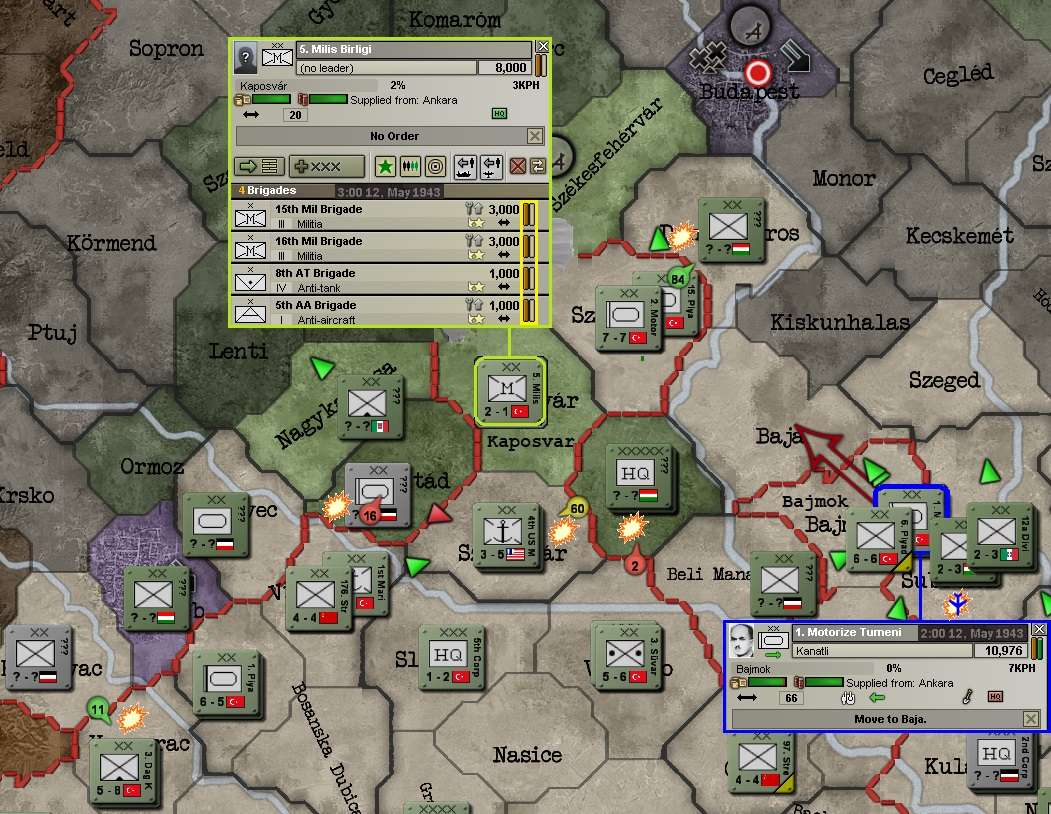
As a desperate measure, with 4 US Mar Div still held up by the attack on Szigetvár, the completely unprepared new 5 Mil Div was [by an allowable game quirk] deployed straight into Kaposvár. It would take some time for them to gain any worthwhile organisation, but it was hoped they might briefly delay any attack there long enough for either the marines to arrive or an alternate supply route opened up through Baja. And even though there were two divisions defending Szigetvár and spoiling attacks on both the enemy divisions involved, those panzers had swung the battle in favour of the Axis.
With the completion of this new militia division, enough capacity was freed up to allow a new project: yet another new wing of the latest Soviet interceptors.
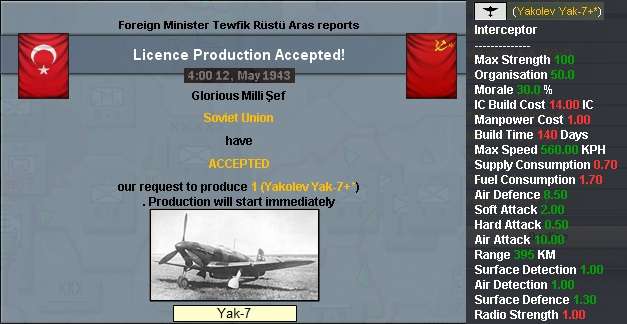
With the spoiling attack on Pécs floundering [just 2% progress], it was called off at 5am before too many lives were wasted (Turkish 36 v 18 Hungarian casualties).
Then at 10am, the barely prepared militiamen in Kaposvár proved their value against an even less innocuous unit: the Hungarian 2nd Army Group HQ trying to escape out of Pécs! Fortunately, the sight of the raw Turkish troops was enough to send the enemy running back without any actual fighting.
17 Inf Div reinforced Bajmok at 2pm, holding it securely along with 6 Inf Div while 1 Mot Div raced north to Baja. An hour later, 1 Mar Div made it to Szigetvár and went into reserve, balancing the ‘morale’ effect of 8 Pz Div which had still not been able to reinforce – very fortunately for the defenders, who seemed to be holding strongly enough.
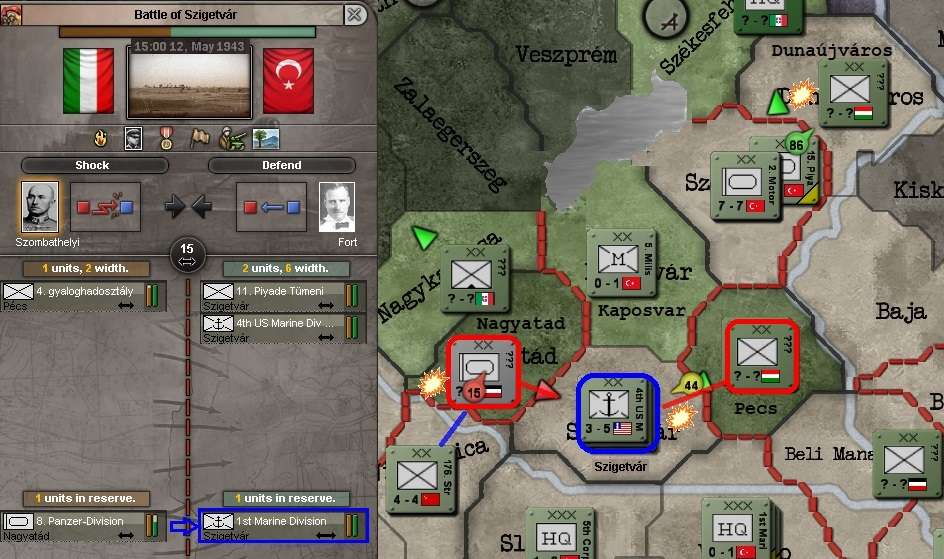
The Turks continued to strike Subotica from the air, around the clock.
13 May 43
Midnight brought another bloody defeat for the Germans in Vrnograc, their attack repelled by an understrength division – 777 of their 4,445 men killed. The Turks lost 303 of the 25,990 defenders engaged.
1 Mot Div occupied Baja without a fight at 3am: the trap was sprung and the Pécs Pocket sealed. An hour later, while the Hungarians still fought to escape from Pécs, the German 46th Infanterie made what looked to be a forlorn attempt to break out of Beli Manastir by attacking Bajmok – but the IS-2 heavy tanks attached to 17 Inf Div and the accompanying infantry of two divisions, some entrenched behind the Danube, would surely be too much for them, especially with no help from outside the pocket.

The news was not so good in Kaposvár: the Italian 4th Mountain Division attacked the unprepared militiamen, who fled without firing a shot. It was a good thing the new supply line through Baja had just been opened, with the Italian mountaineers now expected to march on the abandoned positions.
Then the situation changed again at midday: the Hungarian breakout attack on Szigetvár from Pécs failed, with 4 US Mar Div resuming its interrupted march on Kaposvár and 1 Mar Div being ordered to follow them. The USMC division had only three brigade, so may need some assistance later, while more troops were needed to ensure the pocket remained firmly shut. 11 Inf Div would remain to hold Szigetvár.
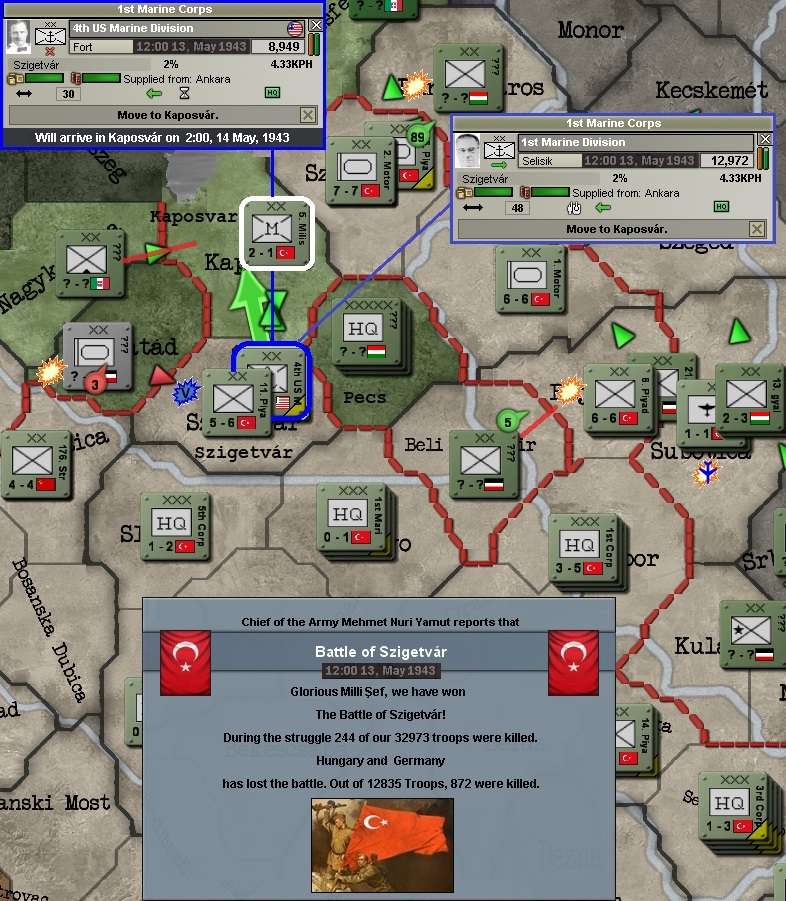
The Hungarian 2nd Division attacked Sombor at 7pm, from Subotica [-22%], where Turkish air strikes continued. 2 Armd and 7 Inf Divs were both still quite badly disorganised from previous combat, but LTGEN Cakmak’s reinforced HQ 1st Corps remained fresh and actually led the defence.
By 9pm that night, 2 Mot Div had finally reinforced in Dunaújváros, which came just in time, with the three-brigade 3 Mot Div beginning to tire – as were the Hungarian defenders. 3 Mot was pulled out of the line to recover as Toüdemür’s 2 Mot took up the baton.
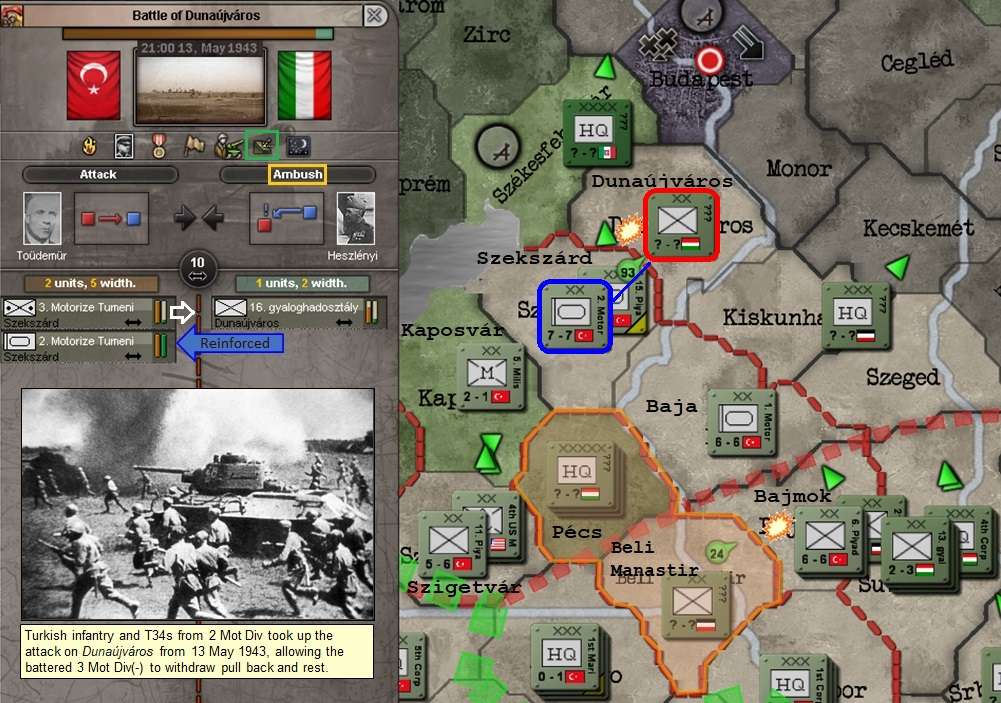
The now isolated ‘Pécs Pocket’ is highlighted in orange in the map above. At this stage, Turkish intelligence had identified a headquarters and two Hungarian infantry divisions trapped in Pécs and one German division trapped in Beli Manastir, which was still trying to break out to Bajmok.
The news remained fairly good over in Romania, where Comintern forces remained on the outskirts of Cluj, even though there were local Axis counter-attacks.
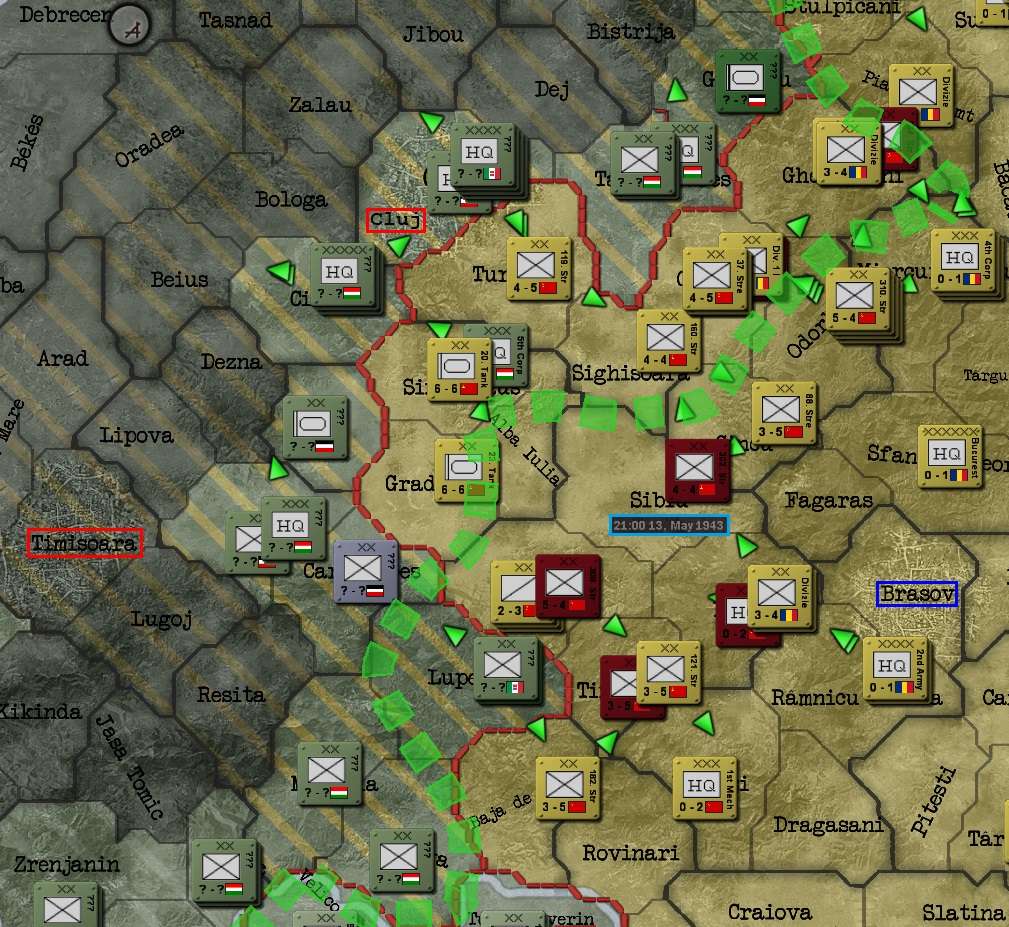
The dotted green line reflects the front line at the end of April 1943.
At 10pm, the US Marines arrived to secure Kaposvár, but were subject to a determined Italian attack before they had a chance to dig even a shell scrape, let alone proper entrenchments.
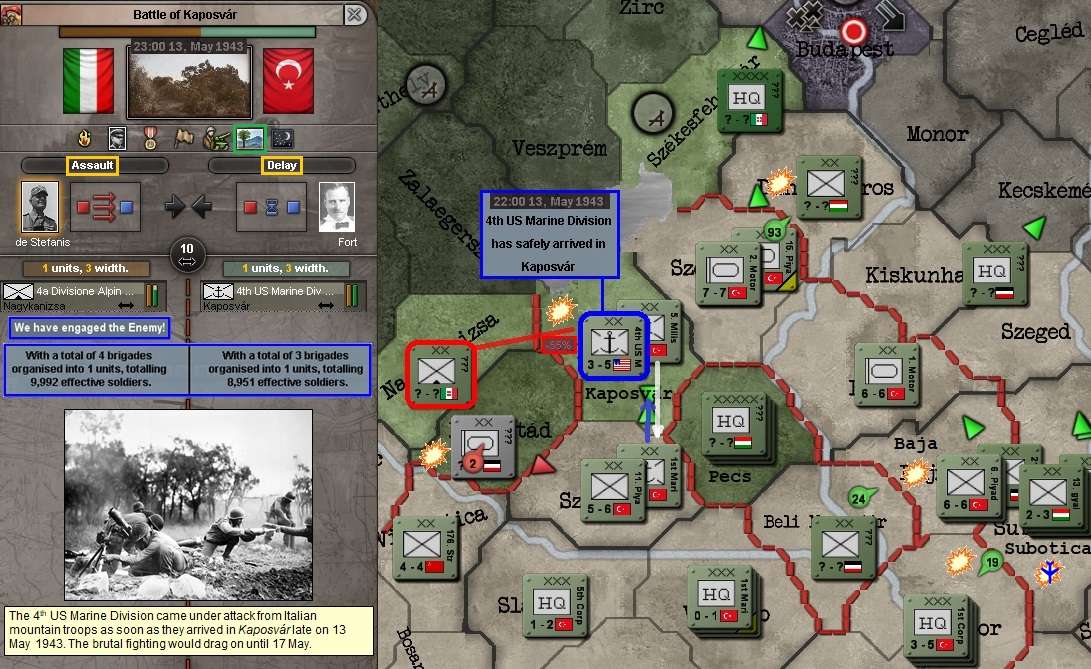
Turkish air preparation of Subotica (now also helping to disrupt the Hungarian attack on Sombor emanating from there) went on throughout the day, at a constant rate of four raids per day.
14 May 43
The next of the new ‘reinforced militia divisions’ (2 x MIL, 1 x AT, 1 x ART), the 6th, deployed at midnight. Unlike their brethren who had been desperately pitched into Kaposvár, these troops would work up in Vrnograc, under MAJGEN Diskoerekto’s overall supervision. The plan was to wait for them to organise, until 1 Armd Div could be released for offensive operations in the breakthrough. The three mountain divisions would be left in this sector to hold the line for now, but later mountainous terrain beckoned to their north-west, where their specialist skills should eventually come into their own.
No new project was commenced, as supply production had been necessarily stepped up to over 71 IC (out of a total economy of 169 IC) because of the sustained offensive, meaning work on the new INT wing in production had fallen to 50%. The manpower reserve hovered at around 63,000 men, down from 71,000 at the start of the month.
After a tough fight which had begun on 9 May with 3 Mot Div attacking and cost 637 Turkish and 687 Hungarian lives, 2 Mot Div won the battle for Dunaújváros at 7am. They secured in an hour later: while they had orders to then move onto Budapest as soon as they could, it was not clear what (if any) garrison the Axis had in place, and Toüdemür’s men would need to reorganise before they could push on.
Victory also came in the defence of Sombor, which had proven very costly for the attackers, with 711 Hungarian troops killed (not including any losses from air raids they may have suffered) for the loss of only 73 Turkish defenders.
Next came the defeat of the German breakout attempt from Beli Manastir on Bajmok, with victory declared at midday, with German casualties this time well over 10-1 (1,186 German and 94 Turkish troops killed). The bratwurst-munching Nazis should now be thoroughly weakened, exhausted and hopefully running out of supplies.
Also at midday, 15 Inf Div finally pulled into forests of Székesfehérvár. As Acting Lieutenant Metin Sadik looked through his binoculars over the Danube, the buildings and spires of Budapest greeted his eyes. As did a demolished bridge.
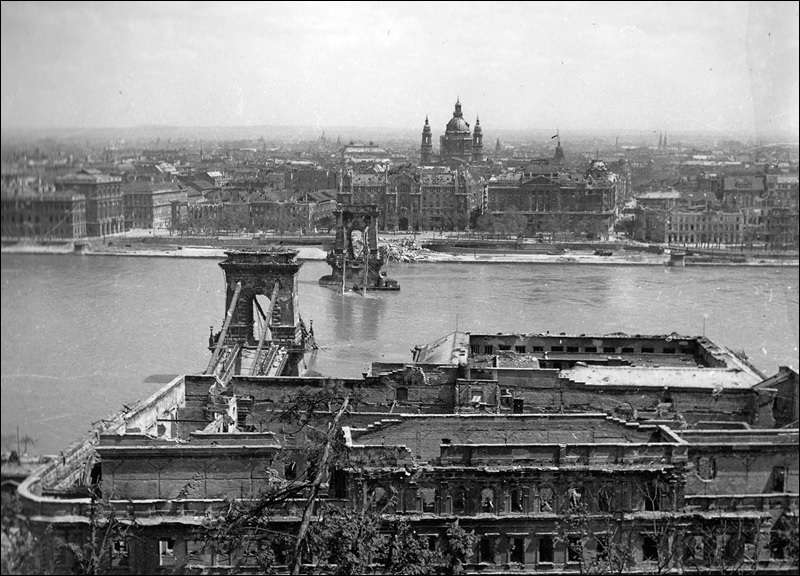
The Danube River flowed under the Szechenyi Chain Bridge in Budapest … until it was intentionally destroyed by German paratroopers in May 1943 to slow the advance of the Turkish Army.
15 Inf Div was ordered straight into the attack, but they came up against a German garrison of the 1st Falschirmjäger Division, entrenched, with fixed fortifications (Level 1), sitting behind the Danube in urban terrain. Gataly ordered his highly experienced troops into determined assault and did have the superior armour of his IS-2s on his side, but the initial odds [1%] did not look promising. 2 Mot Div was still some way off being able to join the attack, as they were still reorganising.
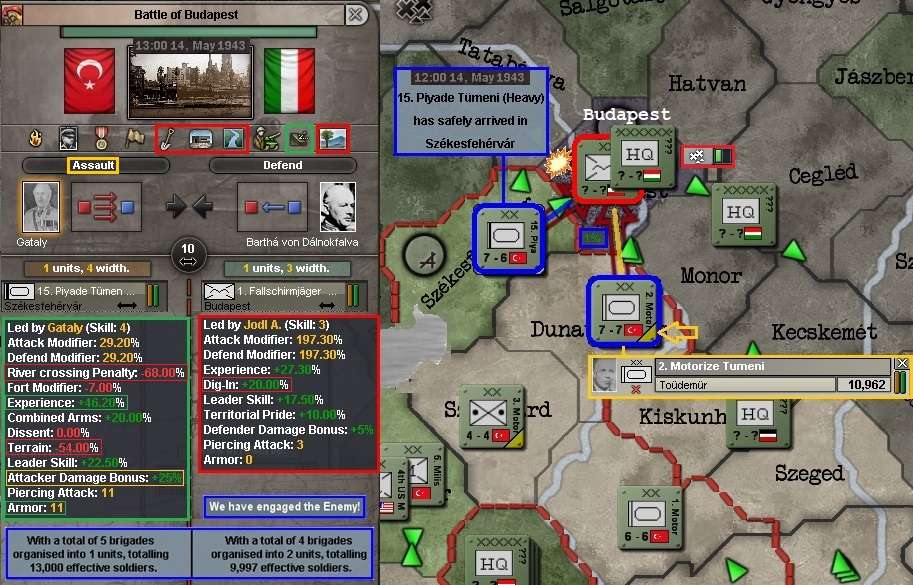
The Hungarians in Pécs were not yet done with their desperate attempts to break out. While the Italians tried to rescue them by reopening Kaposvár [attack at -56%], one of their (still fully organised and supplied) divisions launched an assault on 1 Mot Div in Baja. But this had to be executed over the Danube, against a strong division with medium tanks and partially dug in. Then Kanatli counter-attacked the assault, to negate any advantage the Hungarians might have gained [progress -14%]. The Turkish commander remained confident of holding, unless attacked from the east as well: there was no sign of that yet, with Axis forces still withdrawing to the north-east of them.
The next major action to start was a concerted Comintern attack (two divisions each of Turkish and Soviet infantry) at 6pm on Ruma, the last remaining Axis positions on the Sava River near Beograd. Even though half the attackers were crossing the river, the Hungarians were defending hills and were entrenched, they were badly outnumbered (by more than 6-1) and the attack got off to a good start.
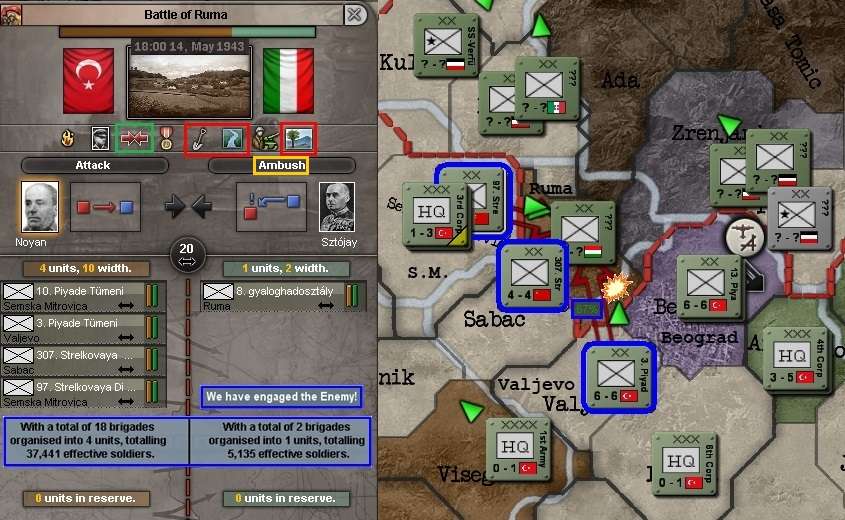
At the same time, the spoiling attack on Nagyatád, which had started back early on the 12th and had been preventing the German 8 Pz Div from attacking the Drava bridgehead at Szigetvár, was called off after disproportionately heavy casualties had been suffered by 176 SD (810 Soviet v 114 German).
The attack on Budapest was also clearly going nowhere and was called of at the same time after only light losses had yet been sustained (33 Turkish v 13 German). The idea here was for 15 Inf Div to begin reorganising for a more concerted attack when more forces could be brought up to hit Budapest from at least one more direction – and preferably with forces on the other side of the river. Perhaps some marines eventually as well, for the river crossings.
The efforts of 1 TAG were switched from Subotica to support the attack on Ruma at 8pm.
Over to the east of the Turkish sector, at 9pm 117 SD was ordered forward to plug a gap between the Turkish right and Romanian left that had opened up at Baja de Arama. East of Beograd, Axis forces looked to have begun thinning out along the Danube, though it was still being defended. Plans began to be drawn up to take advantage of Comintern success in this sector as well.
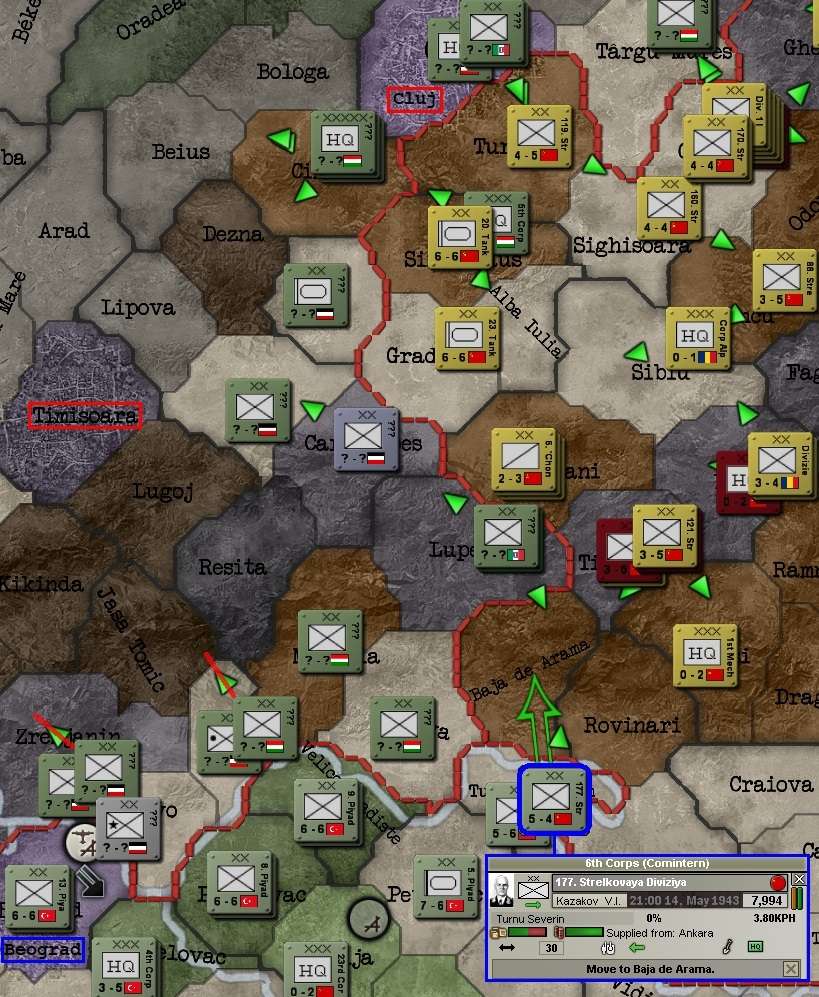
Air Damage Report. Four days of Turkish air raids by the Turks on Subotica from 11-14 May killed a total of 765 Axis troops by the time the mission was completed that night.
15 May 43
Turkish supply organisation received a welcome improvement that day, with better throughput being particularly important as the offensive phase of the war continued and some mechanised units pushed well forward. The research – still not up to contemporary modern standards - was continued.
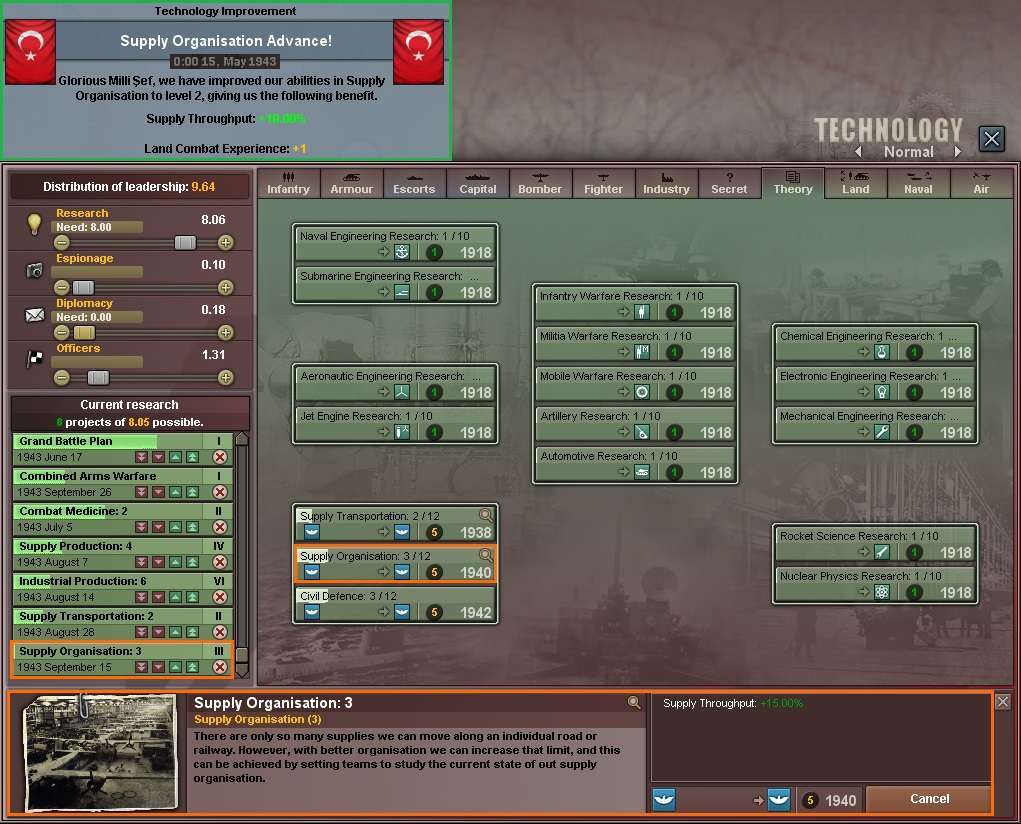
A new marine brigade also deployed [left over from when I must have been contemplating a five-marine-brigade division] and was assigned to the newly deployed 19 Inf Div, part of 1st Marine Corps. It was hoped this would at least give them some advantage when conducting future river assaults, and at least brought them up to a full five brigade establishment. If a second marine division was ever raised, they could be transferred to it. The excess IC was used to bring Yak-7 production up to 100% capacity, with the rest put into supplies (73.3 IC, 43.1% of total output). This would keep the supply stockpile hovering at around 16,000.
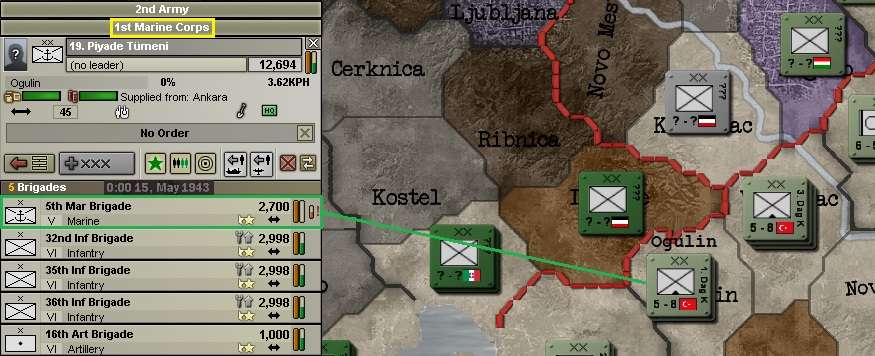
Victory was won in Ruma at 2am, with only light casualties. 1 TAG was switched up to Beli Manastir to see if they could discourage the breakout there and soften the Germans up a bit. It was also a test to see how far south Axis fighters cover extended.
The initial bombing run showed the Germans were below strength and completely disorganised, so an attack was ordered straight away, going in at 8am – when it was confirmed the enemy were also having supply problems, as had been hoped.

But as that went in, it was discovered that Italian interceptor cover did indeed extend that far south. The old Hawk IIIs tried to protect the IL-2s and were joined by more fighters from Beograd (2 & 3 AFs). One of the CAS wings was reduced to two-thirds strength and no organisation, so the mission was cancelled, though they managed to kill a few German soldiers on the ground first.
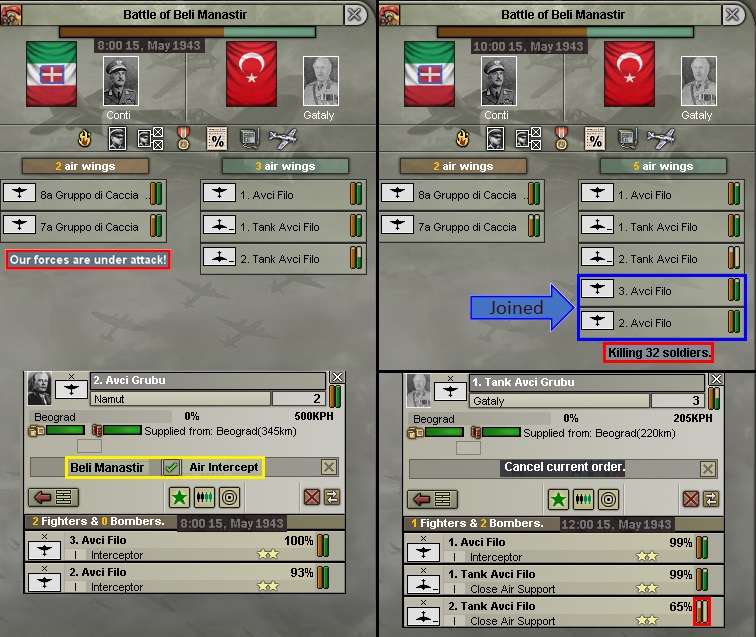
The Germans retreated from Beli Manastir up to Pécs at midday after a short fight, and the air mission, having done its job as a ‘recon in force’, was called off.
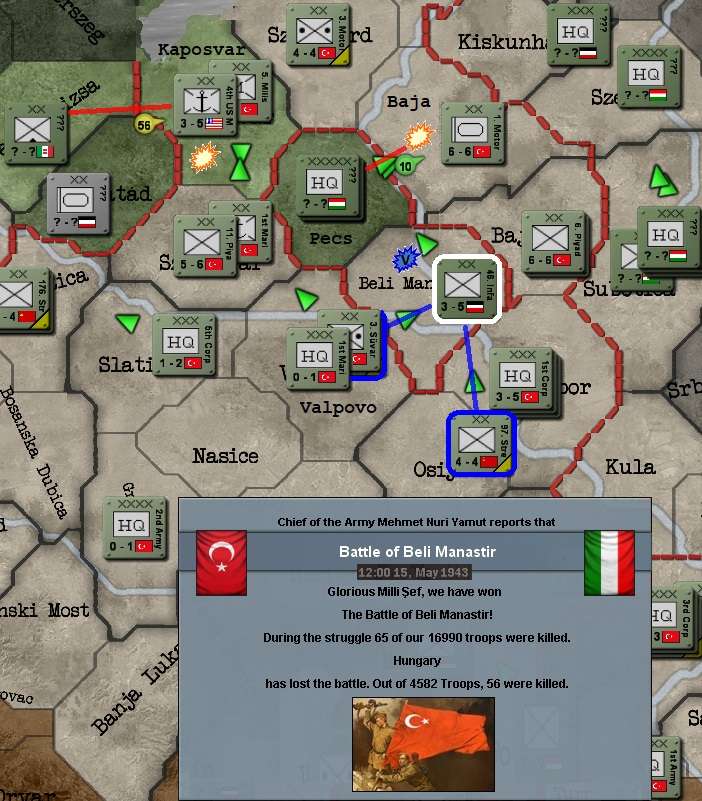
Air Damage Report. The one Turkish raid on Ruma had caused only nine casualties, then 1 TAG caused the 32 in Beli Manastir before operations were called off.
16 May 43
At midnight, Agent SkitalecS3 presented Inönü with the classified SITREP on the northern front. The Germans still maintained a precarious land supply line to their beleaguered Army Group North and had made some ground up south of Leningrad, but the Soviets remained confident as they pushed troops into the salient.
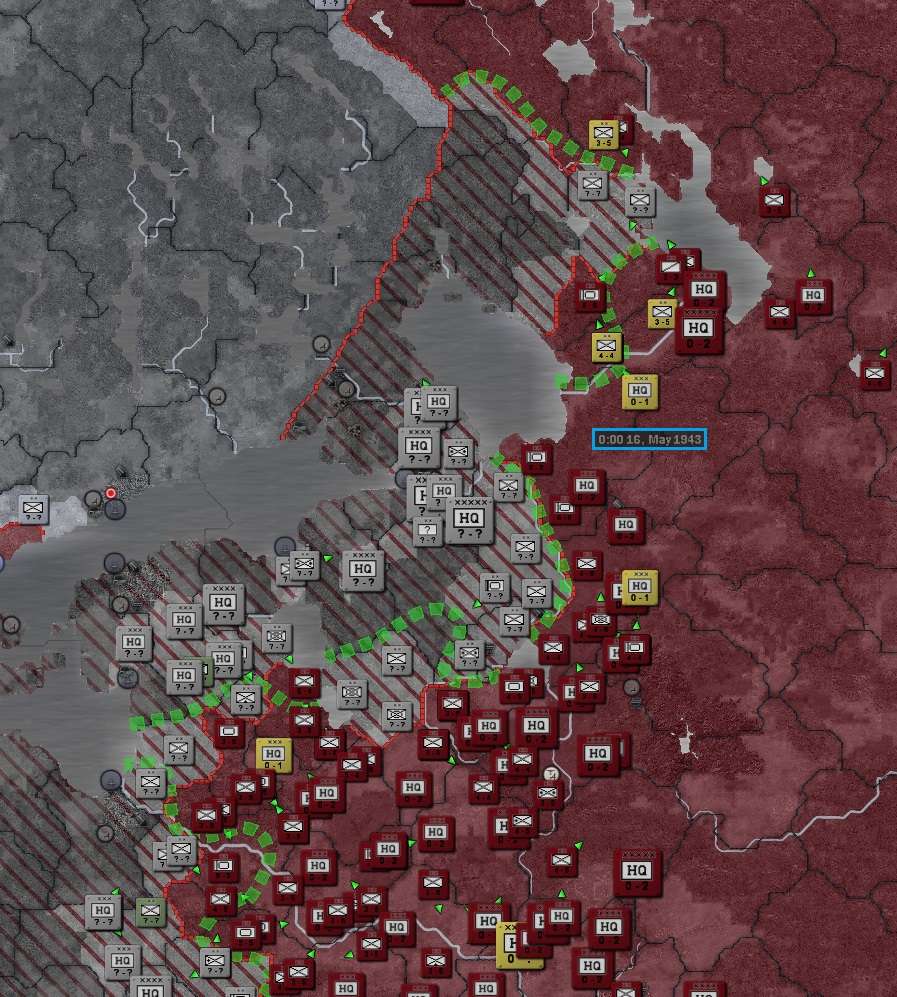
With Axis defences on the far side of the Danube north of Beograd now in some disarray, two divisions were tasked to push across to the currently unoccupied Kula early that morning.
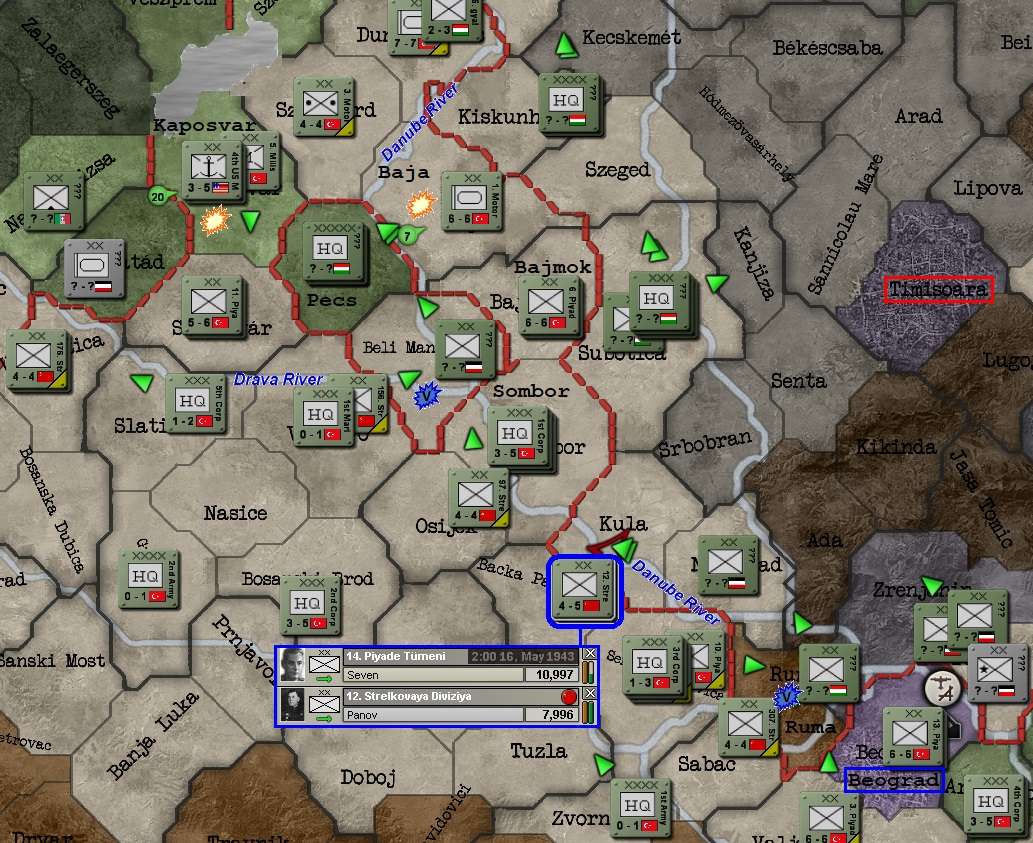
The Turkish 1 Mar Div had just arrived to aid their American comrades in Kaposvár, notionally improving the odds [to -20%], but having no combat effect unless they could reinforce [only 0.4 % chance/round].
And Italian air attacks resumed that morning, with Kaposvár being struck. 4 AG in Split (with longer range multi-role La-5s and P-51Ds) was ordered to intercept these attackers at 6am.
But the Turkish fighters were themselves intercepted over Pécs before they could engage the bombers in Kaposvár, with the La-5s of 5 AF coming off second best, though the Italian fighters also sustained damage.
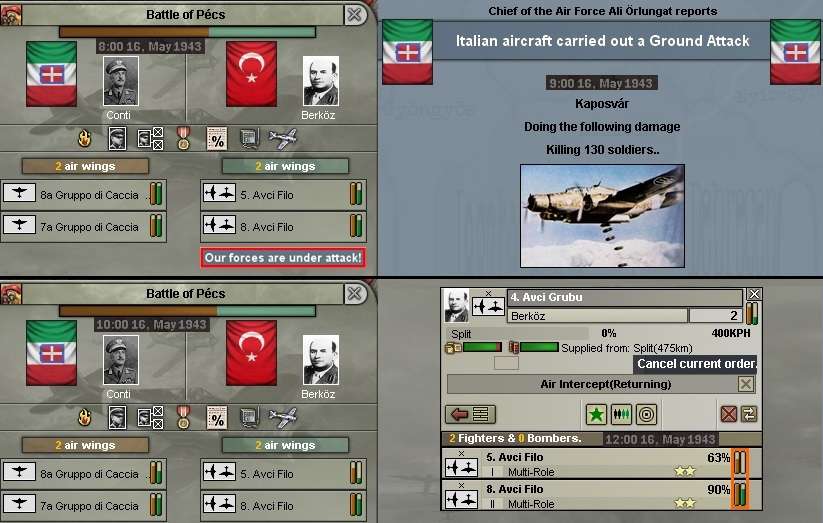
Next, 2 AG was ordered to cover Kaposvár, which they did that night and then into the next morning three times – finding the Italian bombers without escorts of their own each time! The last two raids recorded no friendly ground casualties, and saw the Italians take some heavy damage before calling off their mission.
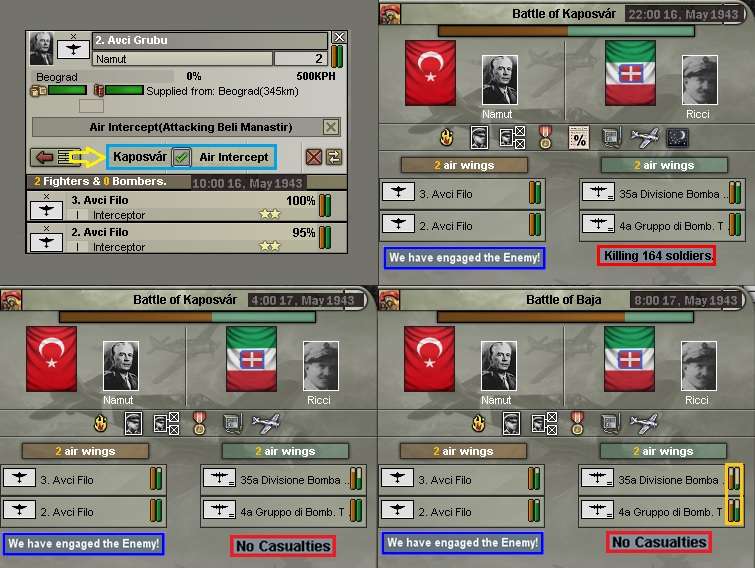
Ruma was liberated at 6pm on 16 May, meaning all land between the Sava and the Danube had been cleared of the enemy.
Just as it looked like Kaposvár should be able to hold out, at 11pm 8 Pz Div joined the attack from the south, in support of the Italians. With both the front line divisions tiring quickly (the 4th US Marines a little more quickly than the attacking Italians), the battle was already turning. If the panzers reinforced, it would likely be over, with the Turkish marines forced to retreat without having reinforced their American colleagues.
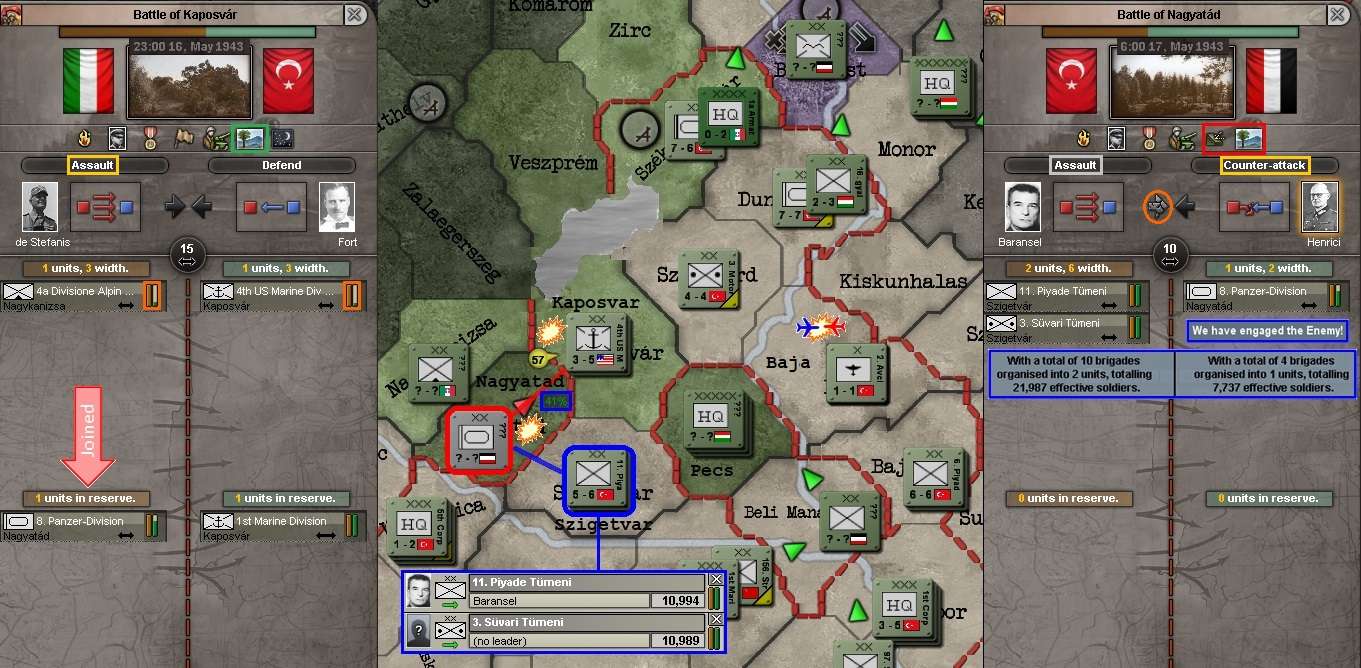
It wouldn’t go in until 6am the following morning, but planning began for a spoiling attack on Nagyatád from Szigetvár by 11 Inf and 3 Cav Divs to try to disrupt 8 Pz Div’s intervention. But when it did go in, in got off to a bad start.
Air Damage Report. The two Italian air raids on Kaposvár had killed 294 Turkish and American marines before they were beaten of by Turkish fighters. One other raid on Baja killed 163 Turks.
17 May 43
The desperate Hungarian attack on Baja failed at 3am: their casualties were horrendous, with 1,034 of their almost 9,000 troops killed, for only 46 Turkish casualties in the defending 1 Mot Div. The survivors of the assault stumbled back to Pécs.
Kula was taken by 12 SD with no opposition at 8am, with 14 Inf Div hot on their heels. 12 SD would probe forward to see if any Axis troops were guarding Srboban.
8 Pz Div duly pulled out of the attack on Kaposvár at 8am, and the spoiler on Nagyatád was stopped as well (46 Turkish v 19 German casualties). But the attack on Kaposvár had almost succeeded, with 4 US Mar Div almost out of organisation and 1 Mar Div yet to reinforce.
156 SD had arrived in Beli Manastir by 10am and now followed up the retreating German 46th Infanterie with an attack on Pécs, hoping to close it out before they could be rescued through the Italians reaching Kaposvár. Just two hours later, the defence did indeed fail at 10am with heavy losses, the Turkish marines never having been able to reinforce.
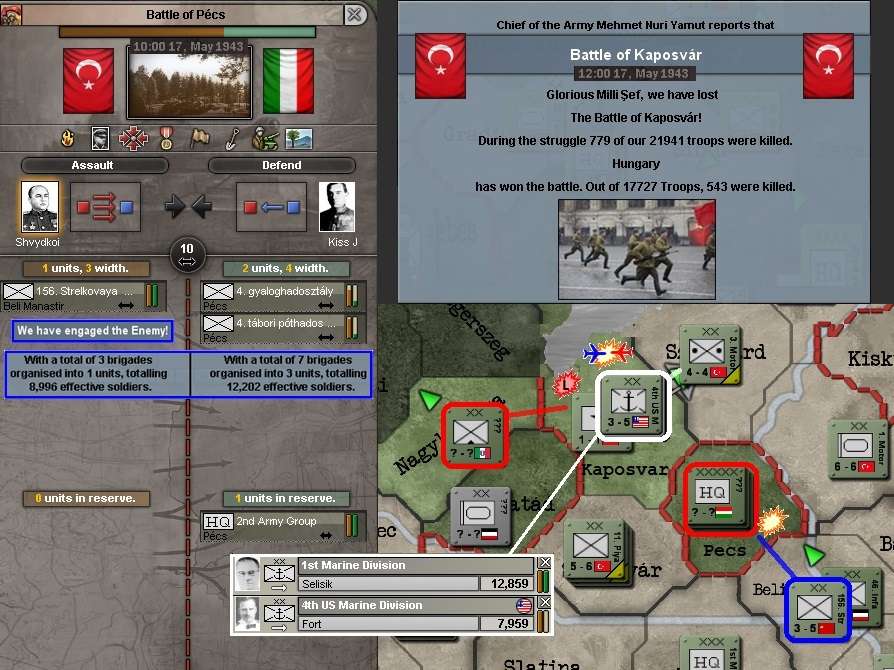
To the east of the Danube front, near the Romanian border, it was now time for a secondary Turkish offensive. 177 SD had secured Baja de Arama at 1pm and brushed off a short probe on arrival. Orsova had been left vacant by the retreating Hungarians, so 5 and 16 Inf Divs were ordered in at 2pm.
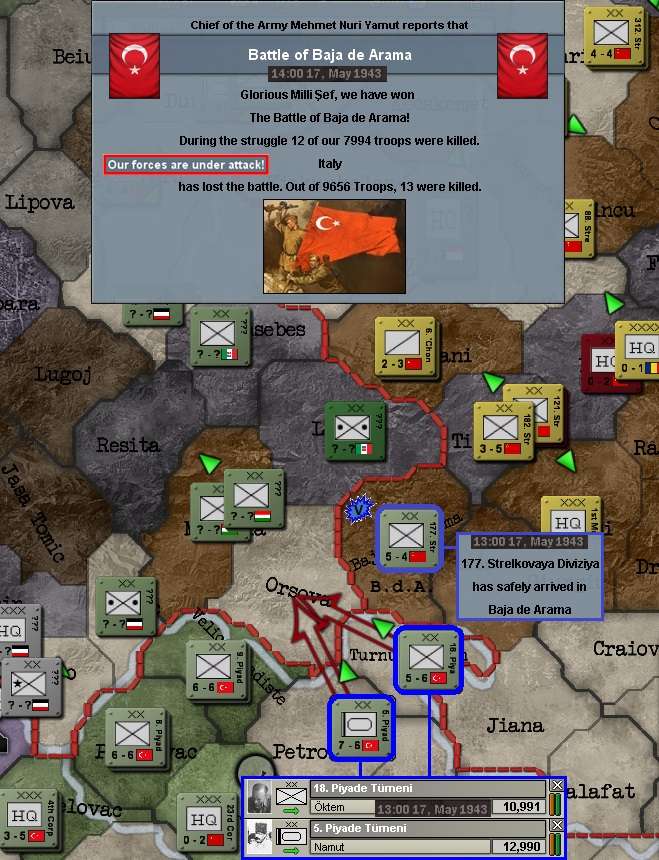
At 4pm, 97 SD ‘Shev’ also arrived in Beli Manastir and followed to support 56 SD’s attack on Pécs. Meanwhile, for reasons never understood, the Italian mountaineers (perhaps too heavily damaged during their attack) did not follow up by advancing on Kaposvár, while 3 Cav Div was now advancing north from Szigetvár to keep the pocket closed shut at Kaposvár.
Air Damage Report. With enemy air strikes starting up on Kula, 2 AG (based in Beograd) was scrambled to provide air cover at 10pm. But there was no air engagement that night, while two Italian raids killed 319 Comintern soldiers in Kula that evening and night. As it happened, the bombings raids on Kula ceased that night, so no interception occurred.
18 May 43
Things went that way until 11am on the 18th, when 97 SD Shev managed to quickly reinforce the attack on Pécs, against the two weakening (but still not out of supply) Hungarian infantry divisions. The Soviet attack on the surrounded Axis troops started to really gain momentum, but the enemy resisted throughout the day.
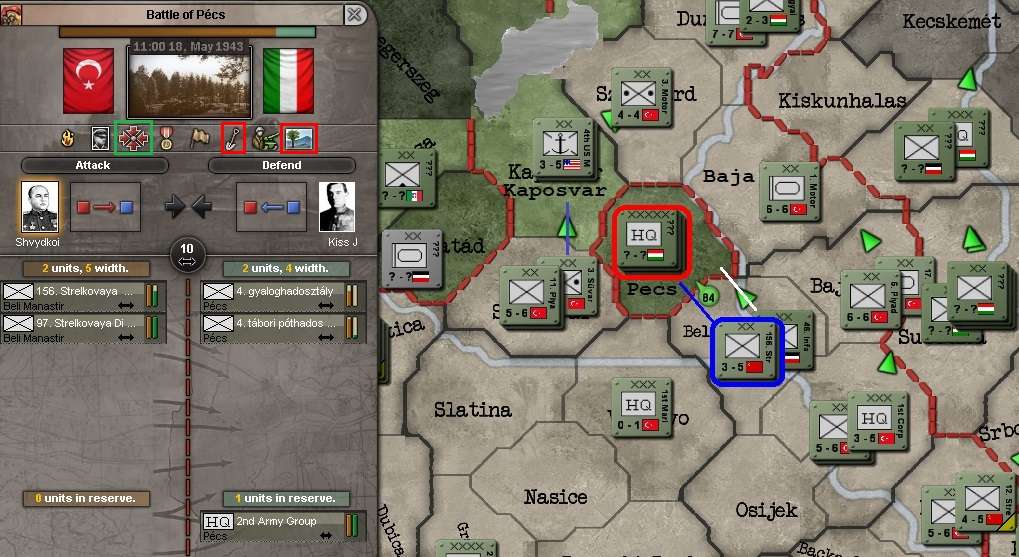
Further south, 12 SD secured Srboban without a fight that evening.
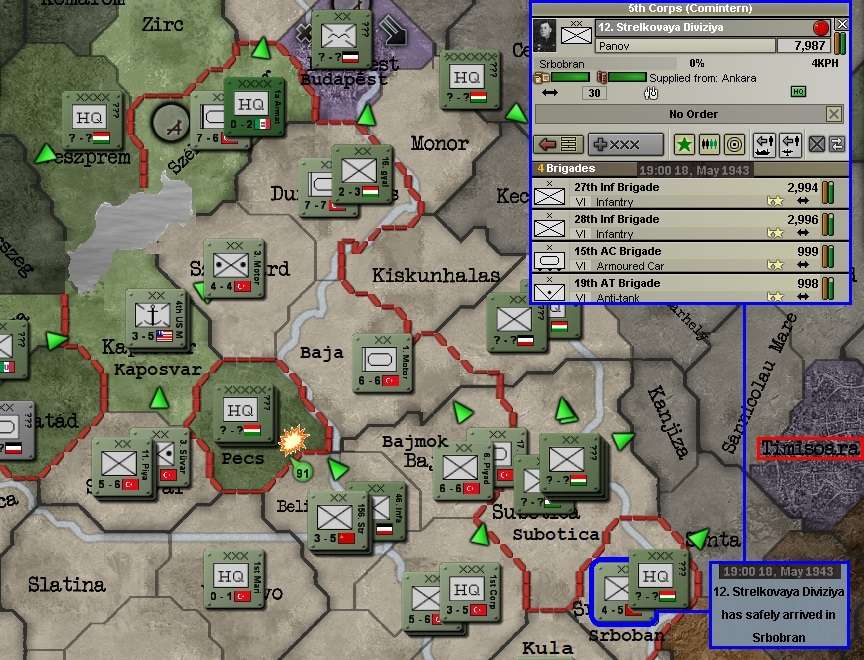
There was no further air action that day, or the next.
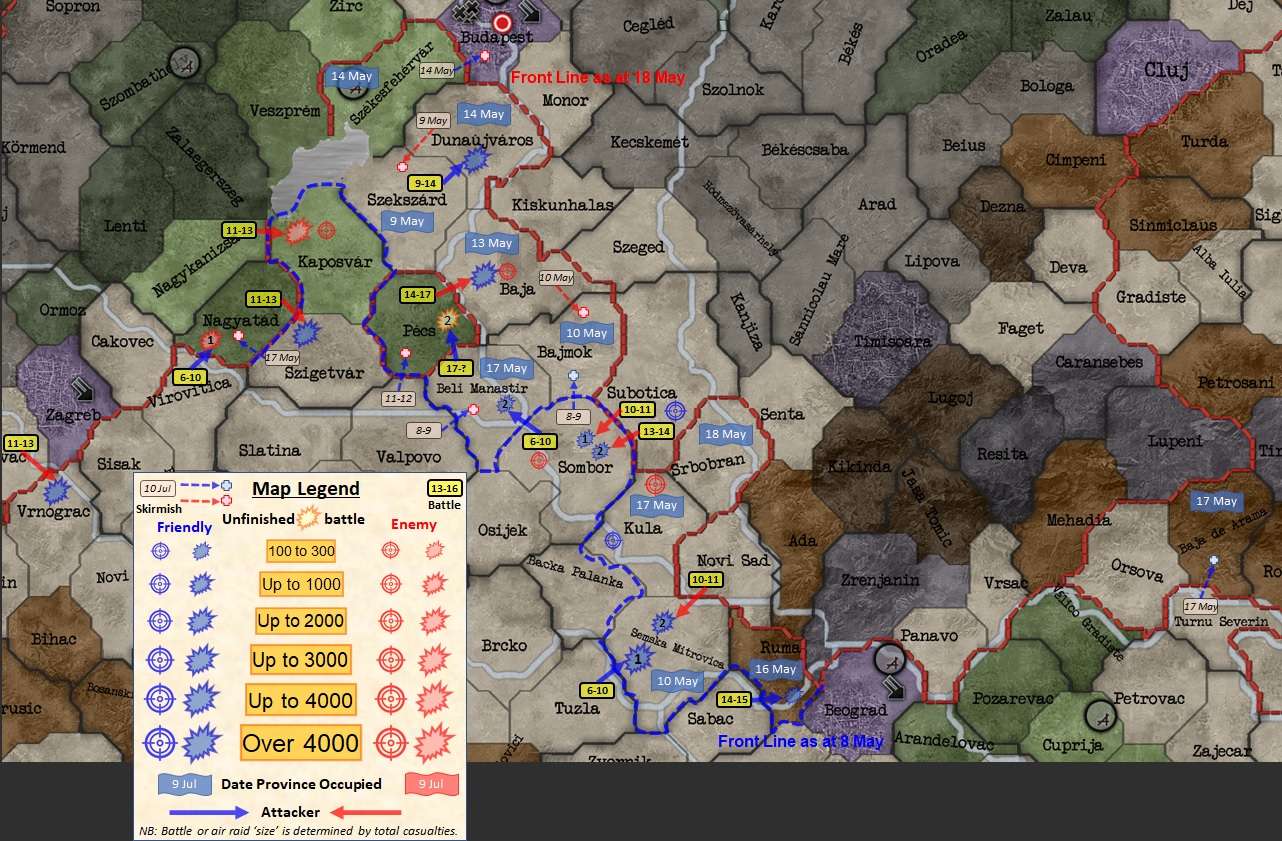
Summary of combat operations, Turkish Front, 9-18 May 1943.
---xxx---
As all that action took place at the front, things remained quiet for Cennet and Vito Corleone in Italy. But in Turkey, things on the espionage front were in a ferment. After the warning (whatever its motivations) B.J. Guildenstern had given Perse in Istanbul on May Day, she was getting increasingly concerned about lurking dangers.
Her worries were exacerbated by rumours of dangerous goings-on in Ankara. There was reputedly a mad French entrepreneur (in fact, undeclared MI6 plant ‘Romeo’, aka Calixte Charon) running somewhat amok on the ‘back streets’, apparently directed his attentions – and considerable political clout, gained through largesse splashed around police and judicial sources – against a certain British cultural attaché (in fact, the MI6 station chief, Donald MacLean – the Soviet double agent).

A pensive Perse worries about where increasingly chaotic events in Ankara may lead.
With the Americans, British and Turks being unaware of MacLean’s true loyalties (and the Soviets carefully saying nothing of them either) this pot seemed to be coming to a dangerous boil. And Perse was worried she may become scalded in the process. And was worried about what she may need to do to protect herself.
Coming Up: The espionage pot boils over in Turkey as ‘Romeo’ continues his personal voyage into the very dark heart of a complicated conspiracy. And some old (and some of them feared) names will be uttered and operators summoned, while others answered calls of affection or duty.
The fighting across the Patriotic Front would continue to rage, as Turkey essentially disregarded manpower erosion to keep pushing their spring offensive as hard as they could, especially aiming to destroy the Pécs Pocket. That would hopefully free up more units to feed into their ongoing offensives towards Budapest, over the Danube towards Timisoara, and the beginnings of a secondary Turkish advance along the Romanian border.
AuthAAR’s Note: Here we have a combat-focused episode, as the Turks and their Comintern partners attempt to capitalise on their recent hard-fought breakthrough in the Spring Offensive. Note, the whole month was played through, so these chapters will progressively bring us back up to the in-game ‘present’ at the end of May 1943.
---xxx---
Recap: The Front Line - 8 May 43
As a reminder of where things are up to, the map below shows action in the breakthrough area during the first eight days of May 1943, as Inönü decided to chance his arm by trying to exploit both north towards Budapest and east to Timisoara – the latter meeting particularly heavy resistance and frequent Axis counter-attacks. Battles continued at Bajmok and Semska Mitrovica.

The blue dotted line shows the front as at 2300 hr on 8 May 1943.
---xxx---
9 May 43
A skirmish in Bajmok was won at 1am as two advancing Turkish divisions brushed away a light defence. If it could be occupied, it started to threaten encirclement of Pécs and Beli Manastir to its west, while also offering another avenue to hook east towards Timisoara, keeping the Axis from firming up a new defensive line.
At 2am, Soviet troops from 12 SD in Backa Palanka joined four other Comintern divisions attacking two Axis divisions in Semska Mitrovica, though were yet to reinforce. Importantly, unlike the other four, if they could reinforce they were not approaching over the Sava River.
Then in the north, later that morning the fast and powerful 2 Mot Div joined 3 Mot Div (-) (which had arrived there the afternoon before) to reinforce the breakthrough into Kaposvár, where they too took the calculated risk of pushing on to Szekszárd before the follow-on units had secured Kaposvár and the supply line running through it. But if they waited, the current opportunity may disappear.

That night, the advance guard of 3 Mot Div (which had no permanent commander) arrived in Szekszárd at 7pm, encountering the unprepared 4th Hungarian Division, which retreated on contact. Having been ordered all the way through, they kept going to Dunaújváros, where they struck the 16th Hungarian Division at 8pm. Their attempted shock attack was however negated by an ambush, though the Hungarians had not had time to dig in [43% progress].
Air Damage Report. Turkish air raids in support of the attack on Semska Mitrovica, which had begun on 6 May, continued throughout the day. Turkish raids on Kula, begun on 8 May, killed 146 Axis troops by the time they finished on the morning of 9 May. There would be no renewal of Axis air attacks until 16 May.
---xxx---
10 May 43
1 Mot Div reported they had arrived at Bajmok at 5am, with 17 Inf Div following up from Sombor. At 6am, the lead elements of the Axis troops trying to escape from Beli Manastir pulled back after a very brief skirmish.

Just an hour later, word came over the radio command net of a major victory in Semska Mitrovica: 2 Inf Div had occupied it just an hour later. But as they waited for the rest of their comrades to join them, they were counter-attacked by German and Hungarian troops at 3pm.


That night, 1 TAG (the IL2s and with Hawk III escorts) were switched to Subotica to try to disrupt the Hungarians attacking Sombor.
Air Damage Report. Ten supporting air raids by the Turks (Yak-4s from 1 TAK) on Semska Mitrovica from the evening of 6 May until the morning of 10 May killed 608 Axis troops.
News Report: Berlin, Germany. On the day that the Enabling Act of 1933 was set to expire by its terms, Adolf Hitler signs an order extending his dictatorship indefinitely. Published in the Reich Law Gazette, the decree stated "The Reich government will continue to exercise the powers bestowed on it by virtue of the law of March 24, 1933. I reserve for myself the obtaining of a confirmation of these powers of the Reich government by the Greater German Reichstag". In Ankara, Prime Minister Celal Bayar was asked for comment, saying: “The criminal Nazi regime in Berlin will be lucky to last another ten months. Herr Hitler and his evil cronies will spend most of that time huddled in bunkers, contemplating the consequences of their inhuman folly, before ending up in front of firing squads. After being found guilty at full and fair trials, of course.”
OTL Event: Battle of Kursk. Hitler approved Operation Citadel, the attack on the Kursk salient, for June 1943.
---xxx---
11 May 43
By 3am, the Hungarians attacking Sombor had had enough: they stopped their assault, having lost 221 men to the Comintern defenders’ 40 casualties. They would continue to suffer more casualties from both Turkish bomber groups for the rest of that day and the next three afterwards.
6 Inf Div were the next to reinforce the breakthrough in Bajmok at 9am, but they were subject to post-attack reorganisation and were therefore unable to push on, where the seizure of Baja would cut off at least three Axis divisions in a possible Pécs-Beli Manastir pocket: the Axis units in Pécs had halted in place.
The enemy attack on Semska Mitrovica failed at 3pm (Comintern 241 v 317 Axis casualties), by which time 2 Inf Div had been joined by two more divisions. At the same time, 15 Inf Div had arrived in Szekszárd, where they were sent north to exploit to Székesfehérvár, in the hope of flanking the continuing battle in Dunaújváros – slipping into Budapest by the ‘back door’.


1. First, the Hungarian 4th Division in Pécs attacked the bridgehead in Szigetvár at 10pm, in an apparent attempt to break out, sever the supply lines of the advance on Budapest and delay the move of 4 US Mar Div in Kaposvár, which had very nearly made it there. Dangerously, German medium panzers in Nagyatád had been spotted advancing from the west, but had not yet joined the battle.
2. Simultaneously, the German 68th Infanterie launched a diversionary attack on Vrnograc, though it appeared MAJGEN Diskoerekto, with the assistance of old Wehib Pasha’s 1 Armd Div, had that situation well in hand.
3. In response, 3 Cav Div in Valpovo was immediately ordered to make a self-sacrificing spoiling attack on Pécs, to see if they could discourage the first attack. It hit home at 11pm, but unfortunately the remaining Hungarian division in Pécs not taking part in that attack was able to concentrate on their defence.
4. At that point, 176 SD was ordered to make a spoiling attack on 8 Pz Div in Nagyatád: again, the odds were bad with another river assault, but it was hoped this would further hamper the attack on Szigetvár.
5. The existing attack by 2 and 3 Mot Divs on Dunaújváros was maintained at full force and 15 Inf Div kept pushing north, even while the battle for their tenuous supply lines went on behind them.
To the south, the Turkish Air Force continued to strike Subotica throughout the day, now with the purpose of softening it up for the next attack.
OTL Event: Operation Mincemeat. U.S. Secretary of the Navy Frank Knox inadvertently gave a clue that Allied forces intended to use Sicily for an invasion of Europe, potentially undermining the British disinformation campaign of Operation Mincemeat to convince German intelligence that the attack would be made from Greece and Sardinia. Ironically, Knox's comment that "Possession of Sicily by the Allies would obviously be a tremendous asset" was interpreted as an obviously clumsy attempt at deception, which Nazi Propaganda Minister Joseph Goebbels would describe as "baseless rumors and attempts at a smoke screen". [Comment: mistakenly tell the truth often enough and it will be interpreted as a lie!]
---xxx---
12 May 43
Kanatli’s 1 Mot Div rolled into Bajmok at 2am and – unhindered by any reorganisation delays – were able to keep going straight towards Baja. Not only might the ‘Pécs Pocket’ be closed off, but it would open up an alternate supply route to the dangerously exposed forces advancing on Budapest.

With the completion of this new militia division, enough capacity was freed up to allow a new project: yet another new wing of the latest Soviet interceptors.

Then at 10am, the barely prepared militiamen in Kaposvár proved their value against an even less innocuous unit: the Hungarian 2nd Army Group HQ trying to escape out of Pécs! Fortunately, the sight of the raw Turkish troops was enough to send the enemy running back without any actual fighting.
17 Inf Div reinforced Bajmok at 2pm, holding it securely along with 6 Inf Div while 1 Mot Div raced north to Baja. An hour later, 1 Mar Div made it to Szigetvár and went into reserve, balancing the ‘morale’ effect of 8 Pz Div which had still not been able to reinforce – very fortunately for the defenders, who seemed to be holding strongly enough.

OTL Event: Washington D.C., US. TRIDENT, the first wartime conference between U.S. President Roosevelt and UK Prime Minister Churchill, began in Washington, D.C., and continued for 16 days. Churchill and his entourage had arrived in Washington from New York the night before after being secretly transported across the North Atlantic Ocean on the RMS Queen Mary. [Comment: things aren't quite so cosy in this ATL, so TRIDENT has not happened.]
OTL Event: Tunisia. Colonel General Hans-Jürgen von Arnim and General Giovanni Messe, commanders, respectively, of the German Army and the Italian Army in North Africa, both surrendered themselves to the Allies, although Arnim refused to sign terms of unconditional surrender of German forces. Arnim and many of his troops had been cornered at the Cape Bon peninsula in Tunisia, near the town of Ste. Marie du Zit, by the 4th Indian Division of the British forces.
---xxx---
13 May 43
Midnight brought another bloody defeat for the Germans in Vrnograc, their attack repelled by an understrength division – 777 of their 4,445 men killed. The Turks lost 303 of the 25,990 defenders engaged.
1 Mot Div occupied Baja without a fight at 3am: the trap was sprung and the Pécs Pocket sealed. An hour later, while the Hungarians still fought to escape from Pécs, the German 46th Infanterie made what looked to be a forlorn attempt to break out of Beli Manastir by attacking Bajmok – but the IS-2 heavy tanks attached to 17 Inf Div and the accompanying infantry of two divisions, some entrenched behind the Danube, would surely be too much for them, especially with no help from outside the pocket.

Then the situation changed again at midday: the Hungarian breakout attack on Szigetvár from Pécs failed, with 4 US Mar Div resuming its interrupted march on Kaposvár and 1 Mar Div being ordered to follow them. The USMC division had only three brigade, so may need some assistance later, while more troops were needed to ensure the pocket remained firmly shut. 11 Inf Div would remain to hold Szigetvár.

By 9pm that night, 2 Mot Div had finally reinforced in Dunaújváros, which came just in time, with the three-brigade 3 Mot Div beginning to tire – as were the Hungarian defenders. 3 Mot was pulled out of the line to recover as Toüdemür’s 2 Mot took up the baton.

The news remained fairly good over in Romania, where Comintern forces remained on the outskirts of Cluj, even though there were local Axis counter-attacks.

The dotted green line reflects the front line at the end of April 1943.
At 10pm, the US Marines arrived to secure Kaposvár, but were subject to a determined Italian attack before they had a chance to dig even a shell scrape, let alone proper entrenchments.

OTL Event: Tunisia. The North African Campaign came to an end after nearly three years, as the 164th Infantry Division of Germany's Afrika Korps laid down its weapons and its commander, Major General Kurt Freiherr von Liebenstein became the last of the Axis officers to surrender in Africa. The commanding British Field Marshal, Sir Harold Alexander, sent word to Prime Minister Churchill, saying that "It is my duty to report that the Tunis campaign is over. All enemy resistance has ceased." During the week, 150,000 Germans and Italians became prisoners of war of the Allies.
---xxx---
14 May 43
The next of the new ‘reinforced militia divisions’ (2 x MIL, 1 x AT, 1 x ART), the 6th, deployed at midnight. Unlike their brethren who had been desperately pitched into Kaposvár, these troops would work up in Vrnograc, under MAJGEN Diskoerekto’s overall supervision. The plan was to wait for them to organise, until 1 Armd Div could be released for offensive operations in the breakthrough. The three mountain divisions would be left in this sector to hold the line for now, but later mountainous terrain beckoned to their north-west, where their specialist skills should eventually come into their own.
No new project was commenced, as supply production had been necessarily stepped up to over 71 IC (out of a total economy of 169 IC) because of the sustained offensive, meaning work on the new INT wing in production had fallen to 50%. The manpower reserve hovered at around 63,000 men, down from 71,000 at the start of the month.
After a tough fight which had begun on 9 May with 3 Mot Div attacking and cost 637 Turkish and 687 Hungarian lives, 2 Mot Div won the battle for Dunaújváros at 7am. They secured in an hour later: while they had orders to then move onto Budapest as soon as they could, it was not clear what (if any) garrison the Axis had in place, and Toüdemür’s men would need to reorganise before they could push on.
Victory also came in the defence of Sombor, which had proven very costly for the attackers, with 711 Hungarian troops killed (not including any losses from air raids they may have suffered) for the loss of only 73 Turkish defenders.
Next came the defeat of the German breakout attempt from Beli Manastir on Bajmok, with victory declared at midday, with German casualties this time well over 10-1 (1,186 German and 94 Turkish troops killed). The bratwurst-munching Nazis should now be thoroughly weakened, exhausted and hopefully running out of supplies.
Also at midday, 15 Inf Div finally pulled into forests of Székesfehérvár. As Acting Lieutenant Metin Sadik looked through his binoculars over the Danube, the buildings and spires of Budapest greeted his eyes. As did a demolished bridge.

The Danube River flowed under the Szechenyi Chain Bridge in Budapest … until it was intentionally destroyed by German paratroopers in May 1943 to slow the advance of the Turkish Army.
15 Inf Div was ordered straight into the attack, but they came up against a German garrison of the 1st Falschirmjäger Division, entrenched, with fixed fortifications (Level 1), sitting behind the Danube in urban terrain. Gataly ordered his highly experienced troops into determined assault and did have the superior armour of his IS-2s on his side, but the initial odds [1%] did not look promising. 2 Mot Div was still some way off being able to join the attack, as they were still reorganising.

The next major action to start was a concerted Comintern attack (two divisions each of Turkish and Soviet infantry) at 6pm on Ruma, the last remaining Axis positions on the Sava River near Beograd. Even though half the attackers were crossing the river, the Hungarians were defending hills and were entrenched, they were badly outnumbered (by more than 6-1) and the attack got off to a good start.

The attack on Budapest was also clearly going nowhere and was called of at the same time after only light losses had yet been sustained (33 Turkish v 13 German). The idea here was for 15 Inf Div to begin reorganising for a more concerted attack when more forces could be brought up to hit Budapest from at least one more direction – and preferably with forces on the other side of the river. Perhaps some marines eventually as well, for the river crossings.
The efforts of 1 TAG were switched from Subotica to support the attack on Ruma at 8pm.
Over to the east of the Turkish sector, at 9pm 117 SD was ordered forward to plug a gap between the Turkish right and Romanian left that had opened up at Baja de Arama. East of Beograd, Axis forces looked to have begun thinning out along the Danube, though it was still being defended. Plans began to be drawn up to take advantage of Comintern success in this sector as well.

---xxx---
15 May 43
Turkish supply organisation received a welcome improvement that day, with better throughput being particularly important as the offensive phase of the war continued and some mechanised units pushed well forward. The research – still not up to contemporary modern standards - was continued.


The initial bombing run showed the Germans were below strength and completely disorganised, so an attack was ordered straight away, going in at 8am – when it was confirmed the enemy were also having supply problems, as had been hoped.



OTL Event: Carlsbad, New Mexico. At an airbase at Carlsbad, New Mexico, Dr. Louis Fieser, the chemist who had developed napalm, conducted the first test of the experimental "bat bomb", with a timed 0.6 ounce explosive attached to a Mexican free-tailed bat. After a demonstration with dummy bombs showed that the bats would, as planned, seek shelter in buildings, Dr. Fieser attached live explosives to six dormant bats for a demonstration in front of cameras. The bats woke up before detonation, then flew towards the wooden control tower, barracks, and other buildings and set a fire that destroyed much of the base. [Comment: one can’t help but conclude that justice was done in this case. Another case of bats emerging victorious over humans.]
---xxx---
16 May 43
At midnight, Agent SkitalecS3 presented Inönü with the classified SITREP on the northern front. The Germans still maintained a precarious land supply line to their beleaguered Army Group North and had made some ground up south of Leningrad, but the Soviets remained confident as they pushed troops into the salient.


And Italian air attacks resumed that morning, with Kaposvár being struck. 4 AG in Split (with longer range multi-role La-5s and P-51Ds) was ordered to intercept these attackers at 6am.
But the Turkish fighters were themselves intercepted over Pécs before they could engage the bombers in Kaposvár, with the La-5s of 5 AF coming off second best, though the Italian fighters also sustained damage.


Just as it looked like Kaposvár should be able to hold out, at 11pm 8 Pz Div joined the attack from the south, in support of the Italians. With both the front line divisions tiring quickly (the 4th US Marines a little more quickly than the attacking Italians), the battle was already turning. If the panzers reinforced, it would likely be over, with the Turkish marines forced to retreat without having reinforced their American colleagues.

Air Damage Report. The two Italian air raids on Kaposvár had killed 294 Turkish and American marines before they were beaten of by Turkish fighters. One other raid on Baja killed 163 Turks.
OTL Event: The Dam Busters. Operation Chastise was carried out by nineteen bombers of the Royal Air Force on German dams in the Ruhr valley industrial region, causing massive flooding and loss of life. The Moehne River dam and the Eder dam contained two-thirds of the water stored for the Ruhr basin. German radio reported that at least 711 people were confirmed dead, and claimed that 341 of them had been Allied prisoners of war. "That night", German Armaments Minister Albert Speer would write later, "employing just a few bombers, the British came close to a success which would have been greater than anything they had achieved hitherto with a commitment of thousands of bombers. But they made a single mistake which puzzles me to this day: They divided their forces and that same night destroyed the Eder Valley dam, although it had nothing whatsoever to do with the supply of water to the Ruhr." [1]
The original Dambusters ‘G for George’ bomber is displayed in Australia’s War Memorial in Canberra. It had a mainly Australian (RAAF) air crew for this mission, including the pilot and co-pilot.
From Wikipedia: G for George is an Avro Lancaster Mk. I bomber, squadron code AR-G and serial number W4783, operated by No. 460 Squadron RAAF during World War II. G-George flew 90 operational sorties over occupied Europe with 460 Squadron, and is the second most prolific surviving Lancaster, behind R5868 S for Sugar of No. 83 Squadron RAF/No. 463 Squadron RAAF/No. 467 Squadron RAAF (137 sorties). Most operational Lancasters were shot down before they had reached 20 sorties: of the 107,085 sorties by Lancasters despatched in bombing raids on Germany 2687 aircraft went missing G-George has the added distinction of bringing home, alive, every crewman who flew aboard it.
From Wikipedia: G for George is an Avro Lancaster Mk. I bomber, squadron code AR-G and serial number W4783, operated by No. 460 Squadron RAAF during World War II. G-George flew 90 operational sorties over occupied Europe with 460 Squadron, and is the second most prolific surviving Lancaster, behind R5868 S for Sugar of No. 83 Squadron RAF/No. 463 Squadron RAAF/No. 467 Squadron RAAF (137 sorties). Most operational Lancasters were shot down before they had reached 20 sorties: of the 107,085 sorties by Lancasters despatched in bombing raids on Germany 2687 aircraft went missing G-George has the added distinction of bringing home, alive, every crewman who flew aboard it.
---xxx---
17 May 43
The desperate Hungarian attack on Baja failed at 3am: their casualties were horrendous, with 1,034 of their almost 9,000 troops killed, for only 46 Turkish casualties in the defending 1 Mot Div. The survivors of the assault stumbled back to Pécs.
Kula was taken by 12 SD with no opposition at 8am, with 14 Inf Div hot on their heels. 12 SD would probe forward to see if any Axis troops were guarding Srboban.
8 Pz Div duly pulled out of the attack on Kaposvár at 8am, and the spoiler on Nagyatád was stopped as well (46 Turkish v 19 German casualties). But the attack on Kaposvár had almost succeeded, with 4 US Mar Div almost out of organisation and 1 Mar Div yet to reinforce.
156 SD had arrived in Beli Manastir by 10am and now followed up the retreating German 46th Infanterie with an attack on Pécs, hoping to close it out before they could be rescued through the Italians reaching Kaposvár. Just two hours later, the defence did indeed fail at 10am with heavy losses, the Turkish marines never having been able to reinforce.


Air Damage Report. With enemy air strikes starting up on Kula, 2 AG (based in Beograd) was scrambled to provide air cover at 10pm. But there was no air engagement that night, while two Italian raids killed 319 Comintern soldiers in Kula that evening and night. As it happened, the bombings raids on Kula ceased that night, so no interception occurred.
OTL Events: European Air War. The ten surviving RAF bombers out of 19 from the "Dam Busters" returned, though only six would survive to the end of the war. And the Memphis Belle's crew became the first aircrew in the 8th Air Force to complete its 25-mission tour of duty. The aircraft and crew, first to survive their tour, returned to the United States to assist in publicity for the sale of War Bonds.
OTL Event: US Research. The United States Army contracted with the University of Pennsylvania's Moore School to develop the computer ENIAC.
---xxx---
18 May 43
Things went that way until 11am on the 18th, when 97 SD Shev managed to quickly reinforce the attack on Pécs, against the two weakening (but still not out of supply) Hungarian infantry divisions. The Soviet attack on the surrounded Axis troops started to really gain momentum, but the enemy resisted throughout the day.



Summary of combat operations, Turkish Front, 9-18 May 1943.
---xxx---
As all that action took place at the front, things remained quiet for Cennet and Vito Corleone in Italy. But in Turkey, things on the espionage front were in a ferment. After the warning (whatever its motivations) B.J. Guildenstern had given Perse in Istanbul on May Day, she was getting increasingly concerned about lurking dangers.
Her worries were exacerbated by rumours of dangerous goings-on in Ankara. There was reputedly a mad French entrepreneur (in fact, undeclared MI6 plant ‘Romeo’, aka Calixte Charon) running somewhat amok on the ‘back streets’, apparently directed his attentions – and considerable political clout, gained through largesse splashed around police and judicial sources – against a certain British cultural attaché (in fact, the MI6 station chief, Donald MacLean – the Soviet double agent).

A pensive Perse worries about where increasingly chaotic events in Ankara may lead.
With the Americans, British and Turks being unaware of MacLean’s true loyalties (and the Soviets carefully saying nothing of them either) this pot seemed to be coming to a dangerous boil. And Perse was worried she may become scalded in the process. And was worried about what she may need to do to protect herself.
---xxx---
Coming Up: The espionage pot boils over in Turkey as ‘Romeo’ continues his personal voyage into the very dark heart of a complicated conspiracy. And some old (and some of them feared) names will be uttered and operators summoned, while others answered calls of affection or duty.
The fighting across the Patriotic Front would continue to rage, as Turkey essentially disregarded manpower erosion to keep pushing their spring offensive as hard as they could, especially aiming to destroy the Pécs Pocket. That would hopefully free up more units to feed into their ongoing offensives towards Budapest, over the Danube towards Timisoara, and the beginnings of a secondary Turkish advance along the Romanian border.
Last edited:
- 3
- 2
- 1
- 1


